Nikon Z6 II Overview
Key Features
- 24.5MP FX-Format BSI CMOS Sensor
- Dual EXPEED 6 Image Processors
- UHD 4K30 Video; N-Log & 10-Bit HDMI Out
- 14 fps Cont. Shooting, ISO 100-51200
- 273-Point Phase-Detect AF System
- 3.6m-Dot OLED Electronic Viewfinder
- 3.2" 2.1m-Dot Tilting Touchscreen LCD
- 5-Axis In-Body Vibration Reduction
- Dual Memory Card Slots
More speed, more versatility, more performance, the Nikon Z6 II is an updated take on the all-rounder mirrorless camera designed for high-end photo and video applications. Despite the wealth of upgrades, the Z6 II retains its familiar form factor and prized image quality to benefit working multimedia image-makers.
Revolving around a 24.5MP BSI CMOS sensor and dual EXPEED 6 image processors, the Z6 II is characterized by an increased buffer depth and faster continuous shooting rate, up to 14 fps with single-point AF or 12 fps shooting in other focusing modes. Video recording at UHD 4K 30p is possible, or up to FHD 120p for slow-motion output, and external recording gains 10-bit out along with N-Log and HLG (HDR) support. The sensor also suits working in a variety of lighting conditions, with sensitivity from ISO 100-51200, and in-body 5-axis Vibration Reduction reduces the appearance of camera shake for sharper handheld shooting. Additionally, the sensor also incorporates a 273-point phase-detection AF system, which now supports Eye-Detect AF in Wide-Area AF modes and during movie recording, and permits focusing in low-light down to -4.5 EV.
Balancing the imaging, the Z6 II retains its overall physical design, however it has been updated with a new dual memory card slot interface to hold one CFexpress Type B card and one SD UHS-II card for more flexible storage. Both a high-res 3.6m-dot OLED EVF and rear 3.2" 2.1m-dot tilting touchscreen LCD lend versatility to image composition and playback, and SnapBridge wireless connectivity can be used for remote camera control, image sharing to a mobile device, and even over-the-air firmware updates.
Firmware version 1.10 unlocks UHD 4K recording at 60p and 50p frame rates, enables raw video output to Blackmagic Design Video Assist external recorders, and improves eye-detection performance when using Auto-Area AF and Wide-Area AF modes.
Second Generation Z
Improving upon their initial efforts, Nikon has revised the Z6 platform to offer more speed, faster processing, and greater versatility without sacrificing the beloved qualities of the original camera.
- Dual EXPEED 6 image processors offer increased buffer performance, a faster 14 fps continuous shooting rate, and noticeably reduced blackout times in the viewfinder.
- Updated autofocus now includes Eye and Face Detection for both humans and animals in the Wide-Area AF mode, for both photo and video recording.
- Timed long exposure shooting is now possible for up to 900 seconds (15 minutes) without the need of an external remote.
- Dual memory card slots offer more flexible file storage capabilities; one CFexpress Type B and one SD UHS-II slot permit overflow, segregated, and repetitive saving options.
- USB Type-C port permits in-camera charging or continuous power for on-the-go charging or extended shooting times.
- The rotation direction of the focus ring on lenses can be switched to suit one's familiarity.
- Support for HDR (HLG) mode when recording externally gives instant HDR-suitable video files for immediate playback. N-Log is also available for enhanced control during post-production and grading, too.
- Future firmware update will add UHD 4K 60p recording, in addition to the current 30p frame rate.
- Eligible for an optional ProRes RAW upgrade, enabling the camera to output ProRes RAW footage to a compatible Atomos external recorder. This upgrade provides greater color grading flexibility with the ProRes codec along with the ability to output uncompressed 12-bit raw footage over HDMI. This upgrade will be available in early 2021.
- The SnapBridge wireless connectivity can be used to update the camera's firmware, instead of relying on a memory card-based system of updating.
- Updated creative shooting modes include Multiple Exposure, 20 different Picture Control settings, and in-camera Timelapse recording. There is also a Focus Shift mode for recording up to 300 sequential frames with the focus position shifted between exposures for focus stacking applications.
- Compatible with optional MB-N11 Power Battery Pack for additional battery life and improved handling.
24.5MP FX-Format BSI CMOS Sensor and Dual EXPEED 6 Processors
A 24.5MP BSI CMOS sensor is used for all-around shooting, impressive low-light quality, and fast readout speeds to benefit continuous shooting, movies, and time-lapse recording. The back-illuminated design of the sensor affords noticeably clean high-sensitivity output for reduced noise when working at high ISO values, up to a native ISO 51200, as well as vivid and smooth quality at sensitivities as low as ISO 100. Benefitting the sensor are dual EXPEED 6 image processors, which affords a wealth of speed throughout the camera system, including the ability to shoot continuously at 14 fps for up to 124 consecutive frames.
UHD 4K Video Recording
Utilizing the sensor and processor attributes for more than just still imagery, the Z6 II is also a more-than-capable multimedia camera. UHD 4K video recording is possible with full pixel readout up to 30p and Full HD 1080p video recording is also supported at up to 120p for slow motion playback. Video files can be saved to the in-camera memory cards or as an uncompressed file to an optional external recorder via HDMI out.
Advanced video functionalities have been added with the Z6 II, including the N-Log gamma for capturing flat-looking footage that maximizes dynamic range and HLG (HDR) for recording HDR-ready footage. Other additions are the ability to output high-quality 10-bit data over HDMI and an Electronic VR function for smooth handheld shooting. Focus Peaking can be used to benefit manual focus control and a Zebra Stripes option is also available to help detect over-exposed areas within the frame. Audio recording can be handled using the built-in stereo microphone or an optional external mic can be added via the 3.5mm stereo jack for greater control over quality, and live monitoring is possible via the headphone jack.
Firmware version 1.10 unlocks UHD 4K recording at 60p and 50p frame rates and enables raw video output to Blackmagic Design Video Assist external recorders, and also improves eye-detection performance Auto-Area AF and Wide-Area AF modes.
273-Point Phase-Detect AF System
Located on the sensor is an array of 273 phase-detect autofocus points covering 90% of the image area both vertically and horizontally. This provides fast and accurate focusing for both stills and video and with a wide coverage area, subject tracking will work out to near the edges of the frame. Hybrid AF is available for video, which will automatically switch between phase- and contrast-detect systems to provide smooth focus during shooting. Additionally, the latest NIKKOR Z lenses are optimized for silent operation.
Vibration Reduction
In-body 5-axis sensor-shift Vibration Reduction compensates for up to 5 stops of camera shake regardless of the Z-type lens being used. This system also works with adapted F-mount lenses, when using the optional FTZ Adapter, where 3-axis stabilization is used.
Body Design
- A large 3.2" 2.1m-dot LCD screen is available for bright, clear, and vivid image playback and live view shooting. The screen has a tilting design to benefit working from both high and low angles, and it is also a touchscreen for more intuitive operation, navigation, and settings control.
- A 3.6m-dot OLED electronic finder is present for comfortable eye-level viewing. It has a high 0.80x magnification and uses NIKKOR optics to guarantee a sharp, clear image. The finder also has a fluorine coating for easier cleaning.
- The top panel of the Z6 II is configured with a dot-matrix OLED. This low-energy display provides quick access to important camera settings.
- Configured with one CFexpress Type B/XQD memory card slot and one UHS-II SD card slot, flexible file storage is possible with the option to use repetitive, overflow, or segregated storage methods.
- A robust magnesium alloy chassis is both dust- and weather-resistant to benefit working in harsh climates and inclement conditions.
- The ergonomic grip and overall form factor is shaped to benefit handling for extended periods of time and is further accentuated by an anti-slip material and a joystick for seamless settings and focus point selection.
- Built-in SnapBridge connectivity to enable seamless transfer of low-resolution imagery as well as remote shooting capabilities. BLE (Bluetooth Low Energy) and Wi-Fi enables communication between the camera and a smart device and, additionally, the mobile device can remotely trigger the shutter and display a live view image from the camera to enable working from a distance. Additionally, SnapBridge can also be used as an easier method of updating the camera's firmware.
Z6 II Firmware Ver. 1.30 (Released 10/19/2021)
- Portrait Impression Balance items have been added to the PHOTO SHOOTING MENU and MOVIE SHOOTING MENU
- The monitor now shows the shooting display while tilted when On is selected for Image review in the PLAYBACK MENU
- Voice memo has been added to the options available for Custom Setting f2 (Custom controls) > Movie record button in the CUSTOM SETTING MENU. In this role, the movie-record button can be used during playback to record and play voice memos up to 60 seconds long.
- Custom Setting f4 (Aperture lock) in the CUSTOM SETTING MENU now available when an FTZ mount adapter is attached
- The flash-ready light on SB-5000 flash units will light if a WR-R10 or WR-R11b is used for wireless remote flash photography
- Fixed: Focus would normally remain locked if the AF-ON button was kept pressed while the shutter-release button was used to take a series of pictures, the camera would refocus without input from the AF-ON button
- Fixed: Custom Setting a6 (AF activation) in the CUSTOM SETTING MENU set to AF-ON only with Enable selected for Out-of-focus release
- Fixed: Continuous L or Continuous H selected for Release mode
- Fixed: Single AF selected for Focus mode
- Fixed: Single-point AF selected for AF-area mode
Nikon Z6 III Overview
Key Features
- 24.5MP Partially-Stacked CMOS Sensor
- EXPEED 7 Image Processor
- 6K 60p N-RAW, 6K 30p ProRes RAW
- 4K 120p, Full HD 240p Slow Motion Video
- Up to 20 fps Raw, 60 fps JPEG Shooting
- Blackout-Free, 5760k-Dot EVF
- 493-Point AF, AI-Based Subject Detection
- 3.2" 4-Axis Tilting Touchscreen LCD
- CFx Type B & SD Memory Card Slots
- NIKKOR Z 24-70mm f/4 S Lens
Sporting a new and inspired partially-stacked sensor design, the Nikon Z6 III Mirrorless Camera unlocks a number of flagship-level upgrades for this mid-range camera, including faster and more precise autofocus, professional-level 6K internal raw video, pre-capture at up to 120 fps, and a smooth, bright, colorful EVF. Taken together, these upgrades make this mirrorless monster an ideal choice for aspiring professionals in search of an all-around, affordable camera.
Newly Designed Sensor and Flagship Processing
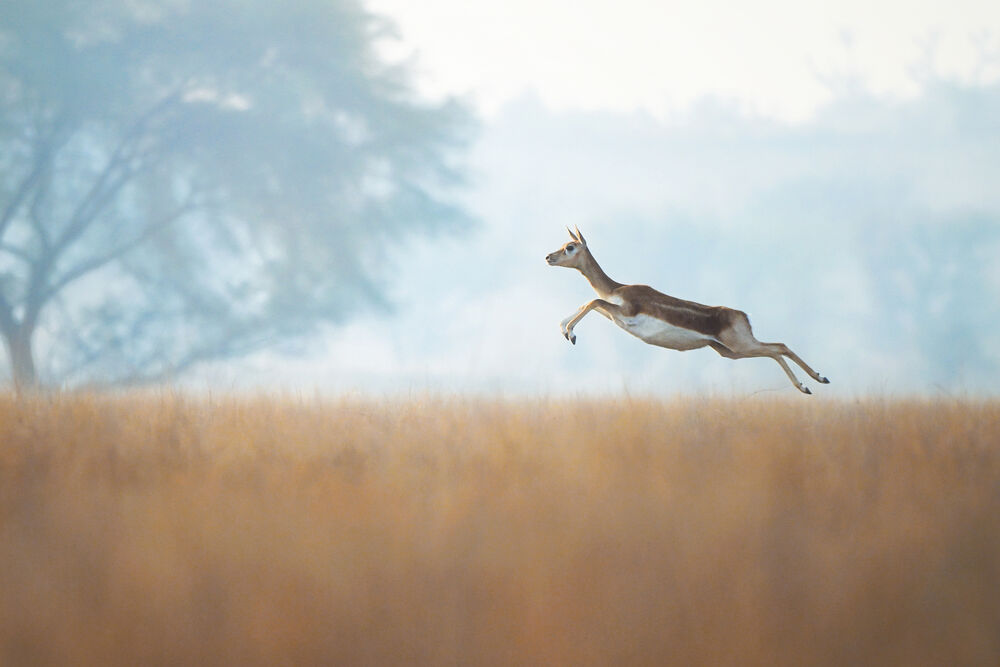
24.5MP Partially-Stacked CMOS Sensor
The Z6 III is Nikon's first camera to to feature a partially stacked sensor design for faster scans and readouts than its predecessor, as well as reducing rolling shutter. Additionally, this sensor design unlocks many of the flagship-level features in the camera, like faster autofocus, a smoother EVF experience, faster continuous shooting speeds, and higher frame rates when shooting video.
EXPEED 7 Image Processor
Complementing the sensor is the EXPEED 7 processing engine, found in the top-of-the-line Z8 and Z9 mirrorless cameras an which offers speeds approximately 10x faster than the Z6II. This engine works in conjunction with the partially-stacked sensor design to realize impressively fast AF speeds, burst shooting rates, a high buffer capacity, fluid video performance, and quick all-around handling.

- Top continuous shooting speeds of 20 fps when shooting in raw, up to 60 fps when shooting in full-frame JPEG, and 120 fps when shooting JPEGs using a DX crop, with all rates supporting full AF/AE performance.
- Able to buffer over 1000 images in a burst when using the electronic shutter, meaning image sequences can be recorded for approximately 50 seconds continuously.
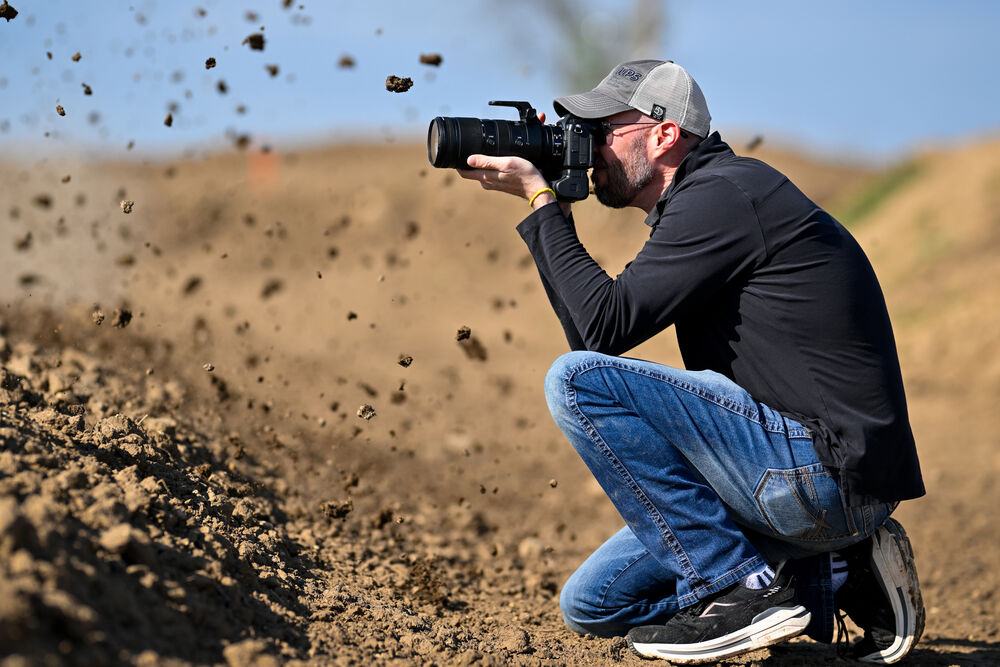
- Pre-Release Capture at up to 120 fps helps make decisive moment shots easier by recording frames in a burst for up to a second prior to actually releasing the shutter. When this feature is activated, burst shooting will commence when the shutter is half-pressed and the buffer will retain up to 4 seconds' worth of frames after fully pressing the shutter.
- Electronic shutter affords a top shutter speed of 1/16,000 sec for working in the brightest conditions with wider apertures.
- Partially-stacked sensor design reduces rolling shutter distortion so fast-moving subjects, like a golf club, tennis racket, or baseball bat, do not appear distorted when working with shutter speeds up to 1/16,000 sec.
- AF calculations are done at a 120 fps rate to keep up with fast continuous shooting speeds.
Fast and Intelligent AF
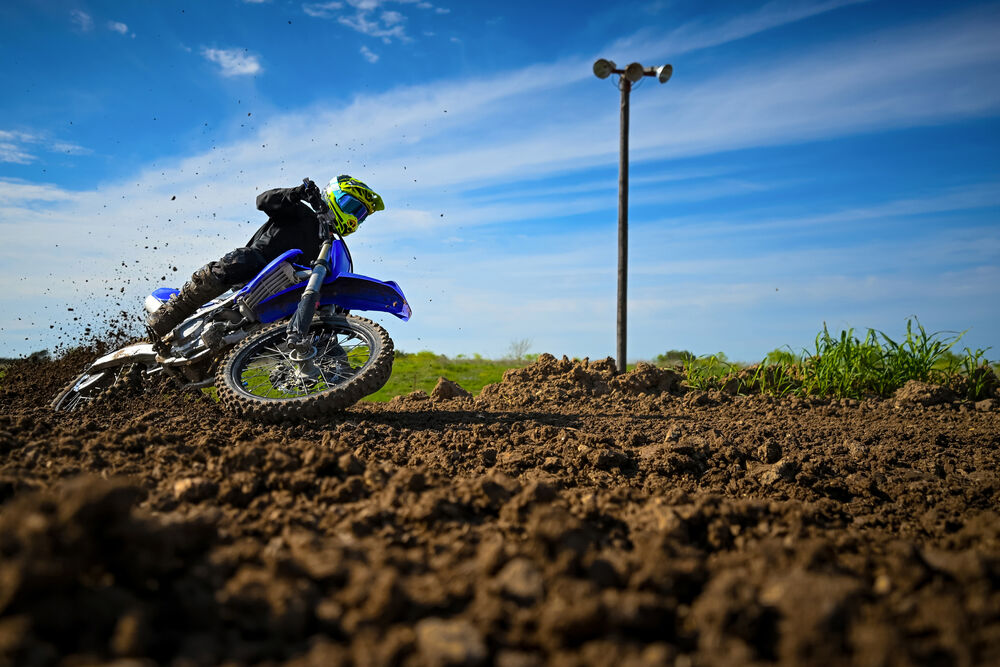
493-Point Phase-Detection AF
Covering the full sensor area, the Z6 III's flagship EXPEED 7 processor unlocks Nikon's flagship 493-point phase-detection AF system to realize fast and accurate focusing performance. This system is benefitted by the high-speed communication of the Z interface along with the speed of the sensor that enables AF readings to occur at up to 120 fps.

This focusing system also supports working in low-light conditions with a Starlight mode that permits focusing down to -10 EV to greatly benefit astrophotography, concert, and other nighttime shooting applications. Featuring the highest native ISO in a Z-series camera at ISO 64000, the autofocus is also useful for working in difficult lighting conditions. The Backlit AF function uses separate pixels on the sensor that allows these areas to intentionally overexpose for focusing accuracy purposes without impacting the actual exposure of the recorded image.
A mainstay focusing mode in DSLRs, which debuted for mirrorless with the Z9, the Z6 III also includes 3D Tracking AF that pairs with subject detection to lock onto fast, erratically moving subjects that move parallel and perpendicular to the camera. Additionally, there are three Dynamic-Area AF modes, with a range of focus area sizes, for capturing a broad variety of moving subject types.

Subject Detection with Deep Learning Technology
Utilizing inherited algorithms and deep learning technology from the Z9, including sophisticated Subject Detection, the Z6 III can recognize a variety of distinct subject types, ranging from humans to animals to airplanes to bicycles. When working in Auto-Area AF, these subjects will automatically be detected, focused on, and tracked to ensure sharp focus when the subject is moving across the frame.
Eye-Detection AF, specifically, has been tuned for improved accuracy and refined recognition of eyes in the scene and can also be used in conjunction with custom Wide-Area AF for different subject shapes and sizes.

More Beautiful Portraits
Perfect for portraits, the Z6 III improves on the partially-stacked sensor's inherent capabilities with a series of processing tools and shooting functions to improve portraits:
- Portrait mode processes portraits for skin with natural texture and a rounded feel
- Rich Tone Portrait mode, a picture mode that produces more vivid results while capturing details of the subject's complexion and avoiding loss of detail in the highlights
- Flat Monochrome mode features gentle gradations from highlights to shadows, producing soft monochrome portraits
- Deep Tone Monochrome mode chooses slightly darker tones in the range from shadows to mid-tones, with brightness rapidly increasing as tones progress from mid-tones to highlights
- Skin softening can be used on up to three subjects in a shot and slightly blurs the skin for a more pleasing texture while still retaining essential sharpness on eyes and hair
- Manual white balance control is more intuitive when making adjustments and Auto WB has also been optimized for human subjects
- Take full advantage of Nikon's portrait modes by pairing the Z6 III with one of Nikon's portrait Z lenses, like the 50mm f/1.2 S, the 85mm f/1.2 S, or the 135mm f/1.8 S Plena
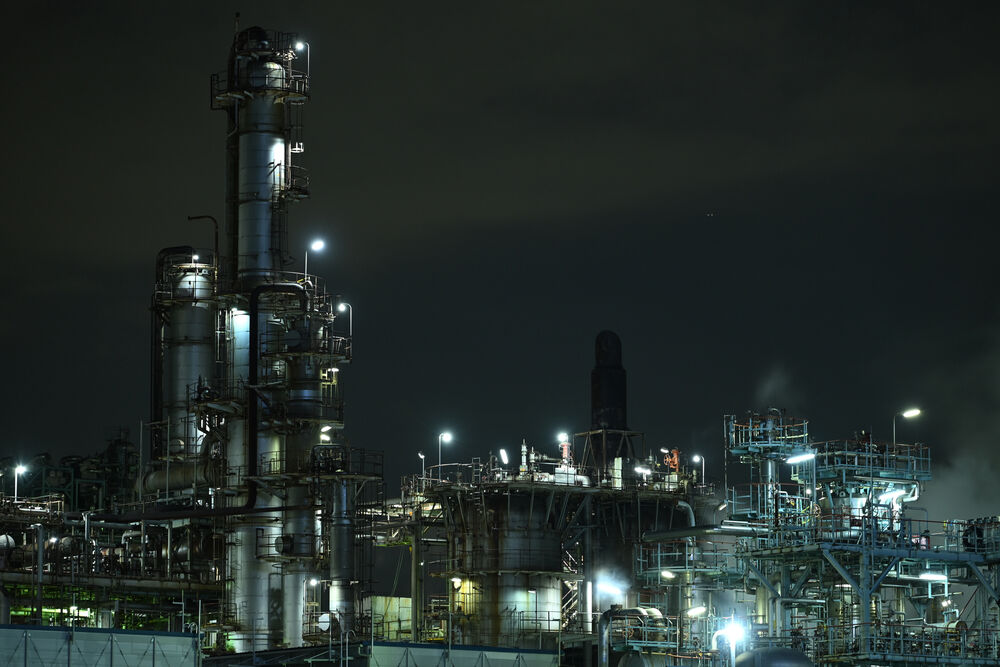
Pixel Shift Technology
Produce ultra-high resolution images at up to approximately 96 megapixels using pixel shift technology. By slightly shifting the image sensor between shots - selectable between 4 and 32 shots per image, with more shots meaning more detail - users can merge the images in NX Studio after shooting to create a single image with enhanced resolution, texture, and color. The shooting method also also reduces noise, moiré, and false colors. Pixel Shift photography benefits archival, landscape, architecture, fine art, macro, and film digitizing applications, and achieves its best results when working with a tripod.
Professional Level Video
Internal 6K60 and 4K 120 Recording
Equally capable for video, the Z6 III approaches the Z9's recording capabilities here, as well, with a variety of resolutions and frame rates available up to 6K.
Using full pixel readout, 6K60p video can be recorded with continuous shooting, while 4K and Full HD recording is also possible in a variety of frame rates, including full-frame 4K recording at up to 120p and Full HD recording at 240p for slow-motion playback.
N-RAW and ProRes RAW Video
Internal 12-bit raw raw recording at up to 6K 60p in the N-RAW format is supported along with internal ProRES RAW HQ. Raw recording offers greater tonal and color latitude and can improve dynamic range, benefitting color grading needs and post-production flexibility.
- N-RAW is Nikon's own raw recording format that offers impressively small file sizes compared to other raw formats as well as the ability to create MP4 proxies for more efficient previewing or transferring.
- N-RAW recording is available at up to 6K at 60p and ProRes RAW is also available at up to 6K and 30p.
ProRes and H.265 10-Bit Recording
Internal recording is also supported with 10-bit color and 4:2:2 sampling in the ProRes 422 HQ codec and 4:2:0 sampling in the H.265 codec at 5.4K 30p and 5.4K 60p, respectively.
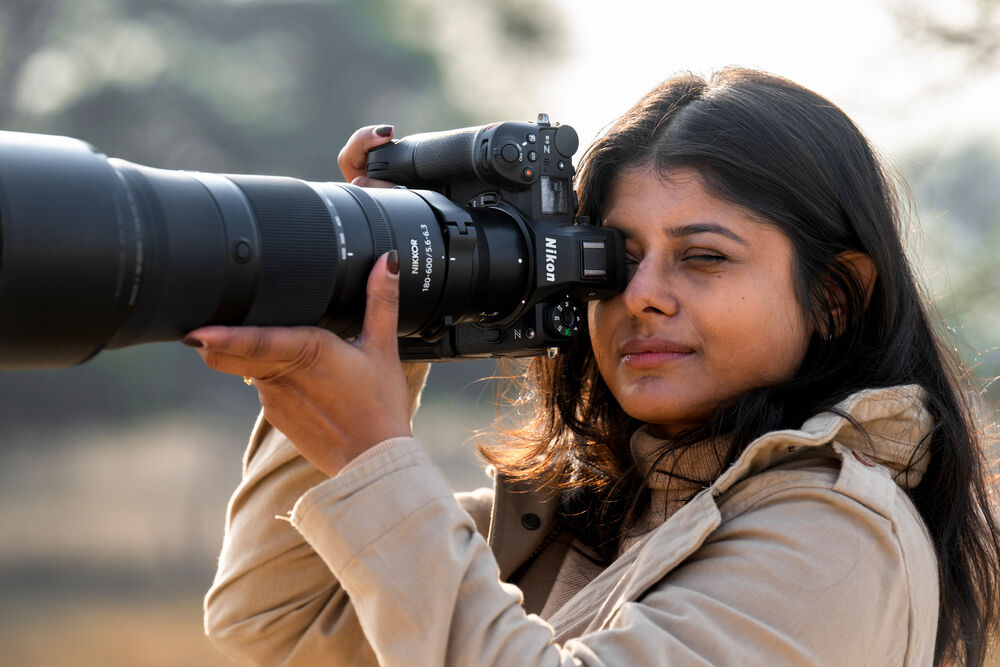
Nikon's Brightest Viewfinder
The Z6 III's sensor-processor combo has allowed Nikon to give the Z6 III the brightest electronic viewfinder on any of its cameras. At 4000 nits, it's 33% brighter than the flagship Z9, making a subject's details visible even in bright sunlight. Its 5,760,000 dot resolution is also a first for a Nikon EVF, aiding with autofocus by showing the subject recognition square. This EVF also features a high fps function, which ups the EVF's refresh rate to 120 fps for smoother, lifelike viewing. Finally, the Z6 III's EVF also features a higher dynamic range and is compatible with a DCI-P3 color gamut - the first of its kind in a mirrorless camera - for approximating real-world color when taking the shot.
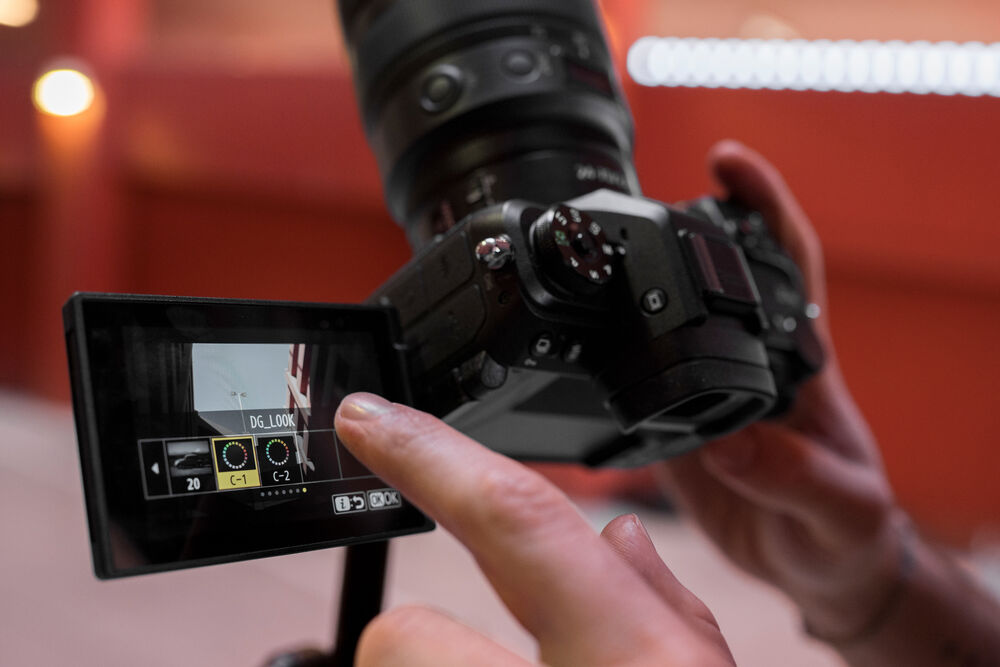
170° Vari-Angle LCD
The Z6 III incorporates a unique 3.2" 2.1m-dot touchscreen LCD that features 170° vari-angle mobility to better support working from high and low angles, regardless if shooting in the horizontal or vertical orientation. This allows for easier viewing from a variety of positions and the user interface orientation will also shift depending on how the camera is held.
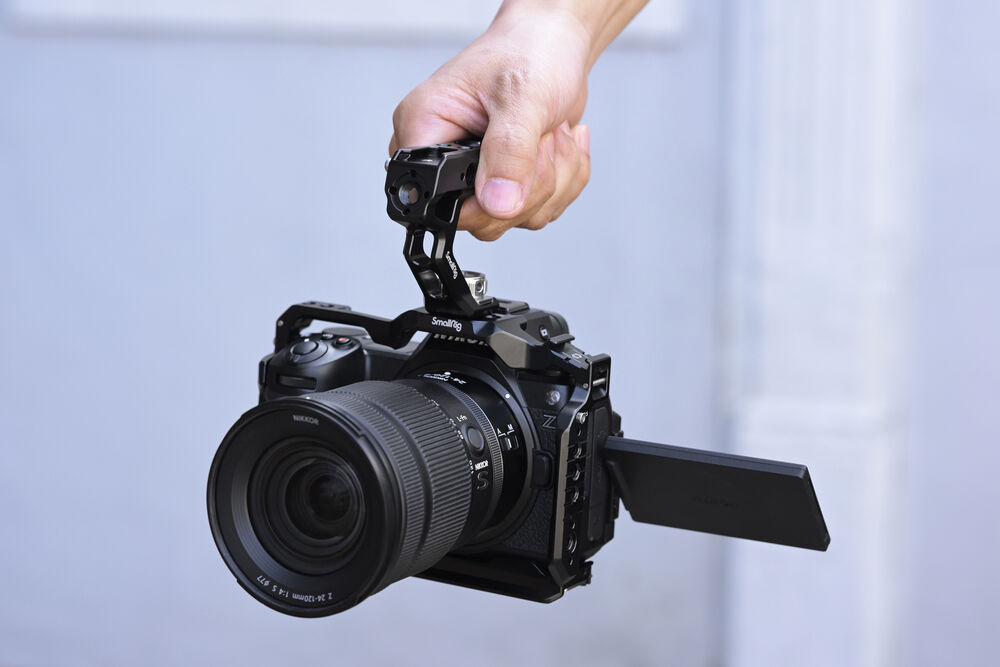
Body Design
- Dual card slots-one CFexpress Type B slot and one UHS-II SD slot-allow for flexible file saving. The CFx slot is suitable for data-intensive applications, like 6K recording and high-speed burst shooting, while the SD slot retains compatibility with the popular storage format. Additionally, the CFx B slot is also compatible with XQD memory cards.
- Pair the Z6 III with the optional MB-N14 Power Battery Pack grip for improved ergonomics when shooting vertical and up to 1.9x the battery life.
- The smaller, lighter design makes the Z6 III an ideal candidate for rigging or use on a gimbal for video use.
- Premium weather sealing protects against dust and moisture for confident use in harsh climates.
- In-body Vibration Reduction now supports Synchro VR to achieve up to 8 stops of camera shake compensation when used with select Z lenses.
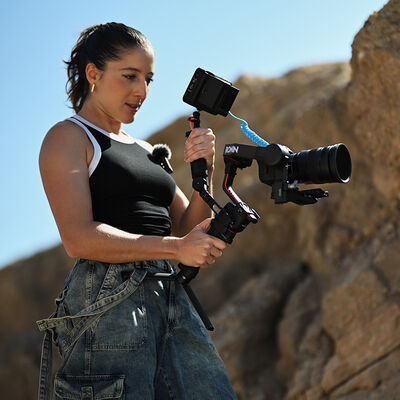
Versatile Connectivity
Matching the professional build quality, the Z6 III is fitted with a variety of connectivity options to suit various workflow needs:
- Another Nikon first, the Z6 III features direct-to-cloud connectivity with Nikon Imaging Cloud for file transfer and access to Nikon's imaging recipes for creative color grading
- Sync timecodes using Ultrasync Blue from Atmos, connecting multiple Z6 III camera bodies for multi-camera production setups
- Full-size HDMI port for outputting video to an external recorder or monitor
- 3.5mm headphone port and a new line-in port for on-board audio monitoring and high-quality audio input directly into the camera
- One USB-C port that supports file transfers and tethering as well as power delivery and battery charging
- USB-C communication terminal supports USB-LAN connectivity when paired with an optional USB-C to Ethernet adapter. This enables a 1000BASE-T wired LAN connection for transferring files over FTP
- 10-pin port offers wide accessories and remote connectivity
- Bluetooth and Wi-Fi (2.4 and 5 GHz) permit wireless transferring of files, remote camera control via a mobile device, and works in conjunction with the NX Mobile Air app for file management
Nikon Z6 III Overview
Key Features
- 24.5MP Partially-Stacked CMOS Sensor
- EXPEED 7 Image Processor
- 6K 60p N-RAW, 6K 30p ProRes RAW
- 4K 120p, Full HD 240p Slow Motion Video
- Up to 20 fps Raw, 60 fps JPEG Shooting
- Blackout-Free, 5760k-Dot EVF
- 493-Point AF, AI-Based Subject Detection
- 3.2" 4-Axis Tilting Touchscreen LCD
- CFexpress Type B & SD Memory Card Slots
- Camera-to-Cloud Direct Connectivity
Sporting a new and inspired partially-stacked sensor design, the Nikon Z6 III Mirrorless Camera unlocks a number of flagship-level upgrades for this mid-range camera, including faster and more precise autofocus, professional-level 6K internal raw video, pre-capture at up to 120 fps, and a smooth, bright, colorful EVF. Taken together, these upgrades make this mirrorless monster an ideal choice for aspiring professionals in search of an all-around, affordable camera.
Newly Designed Sensor and Flagship Processing

24.5MP Partially-Stacked CMOS Sensor
The Z6 III is Nikon's first camera to to feature a partially stacked sensor design for faster scans and readouts than its predecessor, as well as reducing rolling shutter. Additionally, this sensor design unlocks many of the flagship-level features in the camera, like faster autofocus, a smoother EVF experience, faster continuous shooting speeds, and higher frame rates when shooting video.
EXPEED 7 Image Processor
Complementing the sensor is the EXPEED 7 processing engine, found in the top-of-the-line Z8 and Z9 mirrorless cameras an which offers speeds approximately 10x faster than the Z6II. This engine works in conjunction with the partially-stacked sensor design to realize impressively fast AF speeds, burst shooting rates, a high buffer capacity, fluid video performance, and quick all-around handling.

- Top continuous shooting speeds of 20 fps when shooting in raw, up to 60 fps when shooting in full-frame JPEG, and 120 fps when shooting JPEGs using a DX crop, with all rates supporting full AF/AE performance.
- Able to buffer over 1000 images in a burst when using the electronic shutter, meaning image sequences can be recorded for approximately 50 seconds continuously.

- Pre-Release Capture at up to 120 fps helps make decisive moment shots easier by recording frames in a burst for up to a second prior to actually releasing the shutter. When this feature is activated, burst shooting will commence when the shutter is half-pressed and the buffer will retain up to 4 seconds' worth of frames after fully pressing the shutter.
- Electronic shutter affords a top shutter speed of 1/16,000 sec for working in the brightest conditions with wider apertures.
- Partially-stacked sensor design reduces rolling shutter distortion so fast-moving subjects, like a golf club, tennis racket, or baseball bat, do not appear distorted when working with shutter speeds up to 1/16,000 sec.
- AF calculations are done at a 120 fps rate to keep up with fast continuous shooting speeds.
Fast and Intelligent AF

493-Point Phase-Detection AF
Covering the full sensor area, the Z6 III's flagship EXPEED 7 processor unlocks Nikon's flagship 493-point phase-detection AF system to realize fast and accurate focusing performance. This system is benefitted by the high-speed communication of the Z interface along with the speed of the sensor that enables AF readings to occur at up to 120 fps.

This focusing system also supports working in low-light conditions with a Starlight mode that permits focusing down to -10 EV to greatly benefit astrophotography, concert, and other nighttime shooting applications. Featuring the highest native ISO in a Z-series camera at ISO 64000, the autofocus is also useful for working in difficult lighting conditions. The Backlit AF function uses separate pixels on the sensor that allows these areas to intentionally overexpose for focusing accuracy purposes without impacting the actual exposure of the recorded image.
A mainstay focusing mode in DSLRs, which debuted for mirrorless with the Z9, the Z6 III also includes 3D Tracking AF that pairs with subject detection to lock onto fast, erratically moving subjects that move parallel and perpendicular to the camera. Additionally, there are three Dynamic-Area AF modes, with a range of focus area sizes, for capturing a broad variety of moving subject types.

Subject Detection with Deep Learning Technology
Utilizing inherited algorithms and deep learning technology from the Z9, including sophisticated Subject Detection, the Z6 III can recognize a variety of distinct subject types, ranging from humans to animals to airplanes to bicycles. When working in Auto-Area AF, these subjects will automatically be detected, focused on, and tracked to ensure sharp focus when the subject is moving across the frame.
Eye-Detection AF, specifically, has been tuned for improved accuracy and refined recognition of eyes in the scene and can also be used in conjunction with custom Wide-Area AF for different subject shapes and sizes.

More Beautiful Portraits
Perfect for portraits, the Z6 III improves on the partially-stacked sensor's inherent capabilities with a series of processing tools and shooting functions to improve portraits:
- Portrait mode processes portraits for skin with natural texture and a rounded feel
- Rich Tone Portrait mode, a picture mode that produces more vivid results while capturing details of the subject's complexion and avoiding loss of detail in the highlights
- Flat Monochrome mode features gentle gradations from highlights to shadows, producing soft monochrome portraits
- Deep Tone Monochrome mode chooses slightly darker tones in the range from shadows to mid-tones, with brightness rapidly increasing as tones progress from mid-tones to highlights
- Skin softening can be used on up to three subjects in a shot and slightly blurs the skin for a more pleasing texture while still retaining essential sharpness on eyes and hair
- Manual white balance control is more intuitive when making adjustments and Auto WB has also been optimized for human subjects
- Take full advantage of Nikon's portrait modes by pairing the Z6 III with one of Nikon's portrait Z lenses, like the 50mm f/1.2 S, the 85mm f/1.2 S, or the 135mm f/1.8 S Plena

Pixel Shift Technology
Produce ultra-high resolution images at up to approximately 96 megapixels using pixel shift technology. By slightly shifting the image sensor between shots - selectable between 4 and 32 shots per image, with more shots meaning more detail - users can merge the images in NX Studio after shooting to create a single image with enhanced resolution, texture, and color. The shooting method also also reduces noise, moiré, and false colors. Pixel Shift photography benefits archival, landscape, architecture, fine art, macro, and film digitizing applications, and achieves its best results when working with a tripod.
Professional Level Video
Internal 6K60 and 4K 120 Recording
Equally capable for video, the Z6 III approaches the Z9's recording capabilities here, as well, with a variety of resolutions and frame rates available up to 6K.
Using full pixel readout, 6K60p video can be recorded with continuous shooting, while 4K and Full HD recording is also possible in a variety of frame rates, including full-frame 4K recording at up to 120p and Full HD recording at 240p for slow-motion playback.
N-RAW and ProRes RAW Video
Internal 12-bit raw raw recording at up to 6K 60p in the N-RAW format is supported along with internal ProRES RAW HQ. Raw recording offers greater tonal and color latitude and can improve dynamic range, benefitting color grading needs and post-production flexibility.
- N-RAW is Nikon's own raw recording format that offers impressively small file sizes compared to other raw formats as well as the ability to create MP4 proxies for more efficient previewing or transferring.
- N-RAW recording is available at up to 6K at 60p and ProRes RAW is also available at up to 6K and 30p.
ProRes and H.265 10-Bit Recording
Internal recording is also supported with 10-bit color and 4:2:2 sampling in the ProRes 422 HQ codec and 4:2:0 sampling in the H.265 codec at 5.4K 30p and 5.4K 60p, respectively.

Nikon's Brightest Viewfinder
The Z6 III's sensor-processor combo has allowed Nikon to give the Z6 III the brightest electronic viewfinder on any of its cameras. At 4000 nits, it's 33% brighter than the flagship Z9, making a subject's details visible even in bright sunlight. Its 5,760,000 dot resolution is also a first for a Nikon EVF, aiding with autofocus by showing the subject recognition square. This EVF also features a high fps function, which ups the EVF's refresh rate to 120 fps for smoother, lifelike viewing. Finally, the Z6 III's EVF also features a higher dynamic range and is compatible with a DCI-P3 color gamut - the first of its kind in a mirrorless camera - for approximating real-world color when taking the shot.

170° Vari-Angle LCD
The Z6 III incorporates a unique 3.2" 2.1m-dot touchscreen LCD that features 170° vari-angle mobility to better support working from high and low angles, regardless if shooting in the horizontal or vertical orientation. This allows for easier viewing from a variety of positions and the user interface orientation will also shift depending on how the camera is held.

Body Design
- Dual card slots-one CFexpress Type B slot and one UHS-II SD slot-allow for flexible file saving. The CFx slot is suitable for data-intensive applications, like 6K recording and high-speed burst shooting, while the SD slot retains compatibility with the popular storage format. Additionally, the CFx B slot is also compatible with XQD memory cards.
- Pair the Z6 III with the optional MB-N14 Power Battery Pack grip for improved ergonomics when shooting vertical and up to 1.9x the battery life.
- The smaller, lighter design makes the Z6 III an ideal candidate for rigging or use on a gimbal for video use.
- Premium weather sealing protects against dust and moisture for confident use in harsh climates.
- In-body Vibration Reduction now supports Synchro VR to achieve up to 8 stops of camera shake compensation when used with select Z lenses.

Versatile Connectivity
Matching the professional build quality, the Z6 III is fitted with a variety of connectivity options to suit various workflow needs:
- Another Nikon first, the Z6 III features direct-to-cloud connectivity with Nikon Imaging Cloud for file transfer and access to Nikon's imaging recipes for creative color grading
- Sync timecodes using Ultrasync Blue from Atmos, connecting multiple Z6 III camera bodies for multi-camera production setups
- Full-size HDMI port for outputting video to an external recorder or monitor
- 3.5mm headphone port and a new line-in port for on-board audio monitoring and high-quality audio input directly into the camera
- One USB-C port that supports file transfers and tethering as well as power delivery and battery charging
- USB-C communication terminal supports USB-LAN connectivity when paired with an optional USB-C to Ethernet adapter. This enables a 1000BASE-T wired LAN connection for transferring files over FTP
- 10-pin port offers wide accessories and remote connectivity
- Bluetooth and Wi-Fi (2.4 and 5 GHz) permit wireless transferring of files, remote camera control via a mobile device, and works in conjunction with the NX Mobile Air app for file management
SmallRig 2243 Overview
This SmallRig Cage for Nikon Z6/Z7 Camera is a formfitting aluminum alloy cage that protects your camera from the rigors of daily production life without impeding access to your camera's functions, displays, ports, or battery. The camera mounts on the cage via a 1/4"-20 screw, and the mounting surface features anti-slip pads which, in conjunction with the front plate, hold your camera securely in the cage and prevent it from twisting. Additionally, an M2.5 screw is included that mounts onto the cage through the camera's left eyelet, locking your camera to the cage.
An integrated cold shoe mount provides a convenient attachment point for articulating arms, external monitors, and other accessories. The cage incorporates multiple 1/4"-20 and 3/8"-16 threads, some with ARRI-style anti-twist mounts. It also features a NATO rail on the left for attaching accessories. The bottom of the cage is tapped with 1/4"-20 and 3/8"-16 threaded mounting holes to connect a camera plate for tripod mounting.
Accessory Mounting Screw Holes
The cage incorporates twenty-nine 1/4"-20 threaded mounting holes for attaching accessories. It also has eight 3/8"-16 threaded mounting holes, three on top, three on the left, and two on the right side of the cage. Each 3/8"-16 threaded hole on the left, right, and top of the cage features ARRI-style anti-twist divots to help keep your accessory from rotating when attached.
NATO Rails
A NATO rail on the left side of the cage supports mounting accessories and also incorporates threaded mounting holes.
Cold Shoe
An integrated cold shoe allows for mounting accessories with a cold shoe mounting foot.
Nine 1/4"-20 and two 3/8"-16 threaded mounting holes are tapped into the bottom of the cage for mounting the cage on a tripod.
Neck Strap
Slots are machined into the cage for attaching a neck strap.
Avangarde Battery Nikon ENEL15 / ENEL15 + Dual Charger & Dual USB Slot
for NIKON DSLR & Mirrorless
Compatible with :
- Nikon Z7
- Nikon Z6
- Nikon D500
- Nikon D600
- Nikon D610
- Nikon D750
- Nikon D800
- Nikon D800E
- Nikon D810
- Nikon D810A
- Nikon D7000
- Nikon D7100
- Nikon D7200
- Nikon 1 V1, Nikon V1
Deskripsi Produk :
Battery Kapasitas : 1600maH
Charger Avangarde mempunyai 2 Slot dan bisa di Charge bersamaan
Charger Avangarde mempunyai Smart LCD Dual Display Battery , sehingga bisa melihat pengisiian masingmasing battery
Charger Avangarde mempunyai Dual slot yaitu Micro USB dan Type C
Battery Avangarde Kompatibel dengan Pengisi Daya Asli
Battery Avangarde menggunakan Sel Battery berkualitas tinggi
Isi dalam Box : 1x Charger Dual Slot + 2x Battery + 1 Kabel USB Type C
The ENEL15 replacement battery works with Nikon ENEL15 and fully compactible with Nikon D500, D600, D610, D750, D800, D800e, D810, D810a, D850, D7000, D7100, D7200, D7500, 1 v1, Z6, Z7 cameras, Nikon MH25 MH25a charger and more. . (See description for the full compatibility list)
POWERFUL BATTERY CAPACITY It is more power for more shoots (1000 photos) and longer video recording based on the 1900mAh battery capacity
MULTIPLE CHARGING OPTIONS The smart dual can be connected with any cable with 5V USB source like PC, car charger or power bank etc for added charging option. USB with LCD charger provide 2 charging ports to power up your ENEL15 /EL15a battery, one is MicroUSB port and the other is TypeC port
REAL TIME CHARGING STATUS DISPLAY The smart LED charger display the battery charging level real time to prevent your from frequent guessing how much your battery have been charged. it can charge either two batteries simultaneously or 1 battery from any USB Power source
Zhiyun-Tech Crane-2 Overview
The Zhiyun-Tech Crane-2 is a 3-axis handheld gimbal stabilizer supporting mirrorless and DSLR cameras weighing up to 7 lb. Mount your camera on the included Manfrotto-standard quick release plate, balance it, and shoot for up to 18 hours on the supplied batteries. A rod-mount mechanical focus motor is included and can be controlled via the gimbal's handwheel or an optional remote control for the Crane 2. It can be aligned to the focus or zoom ring of your lens for follow focus or zoom control. A support rod, USB cable, and two universal lens gear rings are also supplied for attaching and connecting the focus motor and using it with virtually all lenses.
The Crane-2 also allows for digital follow focus control via the gimbal handwheel for select Canon DSLRs and the Nikon D850 with compatible autofocus lenses. Simply connect the camera to the gimbal with the included USB cables, and after a few settings adjustments you'll have direct follow focus control without requiring the external motor.
The Crane-2 features 360° pan, 320° tilt, and 360° roll adjustment. Multiple different special shooting modes allow you to get extra creative with the gimbal. Full-range POV mode enables 360° synchronous movement on all three axes. This means that the camera will lock into a single position and follow your movements without any limits, as opposed to evening out at some point. This allows for true POV capture.
Gimbal settings are quickly adjustable using the onboard control buttons and an OLED display. For safety, a "slow-fall" feature protects your camera from a sudden drop when the Crane-2 is powered down.
Features
- Includes external rod-mount focus motor for mechanical follow focus/zoom control
- 360° pan, 320° tilt, and 360° roll adjustment
- 7 lb payload
- 18-hour runtime using the included batteries
- Digital follow focus control for select Canon cameras and the Nikon D850 with compatible autofocus lenses
- Manfrotto-standard quick release plate
- "Slow-fall" feature protects your camera from a sudden drop when the Crane-2 is powered down
Firmware Update v1.76 (June 2019)
- Full-range POV: 360° synchronous movement on all three axes—instead of leveling off during motion, the camera will remain locked in position no matter which way or how far you move the gimbal, allowing for true POV shots
- Vortex mode: Add dynamic movements to your barrel shot and open up possibilities
- Direct control support for the Nikon Z6 and Z7 via the control panel—take photos, start/stop recording video, and control various other parameters
Zhiyun Cinepeer Weebill 3E
- Ultra-compact and Lightweight: Just 990g and A4-sized
- Bluetooth Shutter: Wireless control without complicated cables
- Integrated OLED Display: 0.96-inch screen
- Customizable Buttons: Rapidly toggle between shooting modes
- Sling Mode 2.5: Reduce perceived fatigue by more than 40%
Gimbal that Fits Well in Your Hand
As compact as an A4 paper, WEEBILL 3E is your perfect companion on the go. The compact body and ergonomically designed handle make it a joy to carry and use, turning hours-long filming sessions into a breeze.
Bluetooth Shutter Control
Control your camera wirelessly with the WEEBILL 3E via bluetooth. Capture photos and start/stop recordings effortlessly with the touch of a button.
Customizable Buttons
Set shortcuts to rapidly toggle between common shooting modes or activate specialized motions at the press of a finger. The adjustment wheel further expands intuitive control with axes adjustment or camera settings like ISO, aperture and more based on your custom programming.
Native Portrait Switch
Our gimbal's quick-switch design facilitates vertical capture without requiring additional attachments or disassembling components. The quick-release system in WEEBILL 3E transitions your gimbal between perspectives in mere moments.
Sling Mode 2.5
ZHIYUN CINEPEER WEEBILL 3E ushers in Sling Mode 2.5 with an attachable wrist rest and adjustable handle, alleviate over 40% of fatigue while maintaining stability even at extreme low angles. Extend your reach as our customizable handles stretch, contract and expand shooting possibilities.
Professional-grade Stabilization Algorithms
Equipped with ZHIYUN's pro Algorithms, the WEEBILL 3E glides through buttery smooth camera moves. Its potent motors can handle leading full-frame cameras with ease.
Long Runtime
The built-in 2650mAh batteries boast enough capacity to handle even the longest filming on a single charge. Creators can tackle up to 16 hours of operating time per full charge. You can also operating while charging so that your creativity never stops.











Optional Sling Grip Efficient Control Advanced Algorithms Comparison
Camera Compatibility List - Cable & Bluetooth Control
| Cable Control for Sony | α1, α9 Ⅱ, α9, α7R5, α7R4, α7M4, α7R3, α7M3, α7S3, α7R2, α7M2, α7S2, α7C, α7CⅡ, a6700, a6600, a6500, a6400, a6300, a6100, ZV-1, ZV -E10, ZV-E1, ILME FX3 |
| Cable Control for Canon | 5D Mark Ⅲ, 5D Mark Ⅳ, 5DS, 5DS R, 6D Mark Ⅱ, 80D, 90D, 800D, 850D, R6 Mark Ⅱ, R50, 200D Ⅱ, M50, M6 Mark Ⅱ, R5, R6, R7, R8, R10, EOS R, EOS RP |
| Cable Control for Nikon | D850, D780, Z5, Z6, Z6 Ⅱ, Z7, Z7 Ⅱ, Z8, Z30, Z50, Z fc |
| Cable Control for Panasonic | G9, GH5, GH5S, GH6, S5, S5Ⅱ, DC-BGH1 |
| Cable Control for Fujifilm | X-T3, X-T4, X-T5, X-H2, X-H2s |
| Cable Control for Olympus | OM-D E-M1 Mark II |
| Cable Control for ZCAM/SIGMA | ZCAM E2, SIGMA fp |
| Bluetooth Control for Sony | α1, α9 Ⅱ, α9, α7R5, α7R4, α7M4, α7R3, α7M3, α7S3, α7C, α7CⅡ, a6700, a6600, a6400, a6100, ZV-1, ZV-E10, ZV-E1, Rx100 VII |
| Bluetooth Control for Canon | R5, R6, R7, R8, R10, EOS R, EOS RP, R6 Mark Ⅱ, R50, M50, M6 Mark Ⅱ, 90D, 800D, 850D, 200D Ⅱ |
| Bluetooth Control for Nikon | Z6 Ⅱ, Z7 Ⅱ, Z30, Z50, Z fc |
Falcam F22&F38&F50 Quick Release Foldable Half Cage Kit C00B3809
Key Features
- Two Rotating Shaft Designs
- Compatible with F22, F38 and F50 Quick Release System
- 1/4"-20 Threaded Holes
- ARRI Locating Holes &Strap Holes
- Wire Clamp Locating Holes
- Anti-mistouch & Anti-deflection Design
- Ultra-portable Foldable Design
- Half Cage's Flat State (maximum lever) Can Bear 4.5kg
- Fit Multiple Camera Models
Overview
The Falcam Foldable Half Camera Cage offers a versatile solution for various shooting scenarios. It features a unique dual-axis design that allows you to adjust the angles of the top, side, and bottom plates with ease, transforming it from a full cage into a half-cage configuration. The half-cage's bottom plate is equipped with an F38 quick-release interface, enabling effortless camera assembly and disassembly.
This cage is compatible with the F22, F38, and F50 quick-release systems, offering a range of attachment options such as 1/4" threaded holes, ARRI locating holes, wire clamp locating holes, strap holes, and cold shoe mounts to meet diverse expansion needs. It features a double-locking mechanism for enhanced stability, ensuring your camera stays securely in place.
The Falcam Foldable Half Camera Cage is compatible with a wide range of cameras, including Sony, Canon (R5/R6/R7/R10), Nikon (Z5/Z50/Z6/Z60/Z7), Fuji (XT series, XH series), and more. For certain blocky camera models like the Nikon Z8/Z9, the cage offers a unique vertical top plate installation method, similar to an L bracket.
With the option to pair it with Falcam F22, F38, F50, or Maglink quick release accessories, you'll experience seamless and fast transitions between different photography scenarios. Don't miss the opportunity to make your photography more versatile and efficient with the Falcam Foldable Half Camera Cage.
Camera Compatibility List
- Sony: A7 IV, A7R V, A7S III, A7 III, A7R IVa, A7R IIIa, A7C, A7C2, A6700, A6600, A6400, A6100, ZV-E1, ZVE-10, ZV1, FX3, FX30
- Fujifilm: X-T1, X-T2, X-T3, X-T4, X-T5, X-T20, X-T30, X-S10, X-S20, H1, X-H2S
- Lumix: S5, S5MK2, S5M2X, G9, DH6A, GH6L, G95D, G7, G100K
- Canon: R5, R6, R6MK2, R7, R8, R10
- Nikon: ZFC, Z30, Z5, Z50, Z6, Z60, Z7
- Sigma: FP, FPL
- Olympus: E-M10, OM-5, OM-1
SmallRig 3866 Overview
Key Features
- Formfitting Aluminum Cage
- M2.5 Anti-Twist Locking Side Screws
- Multiple 1/4"-20 and 3/8"-16 Threads
- Integrated Bottom/Side Arca-Type Mounts
- 2 x Built-In Shoe Mounts
- Allen Wrench Stores on Bottom of Cage
- Durable Aluminum Construction
Protect and add accessories to your Nikon Z7 II or Z6 II camera when the MB-N11 battery grip is installed with this Camera Cage from SmallRig. The formfitting aluminum cage protects your camera without impeding access to your camera's functions, displays, ports, or MB-N11 battery grip door. The camera mounts on the cage via a 1/4"-20 screw, and the mounting surface features anti-slip pads that, in addition to two M2.5 screws on the sides, hold your camera securely in the cage and prevent it from twisting.
There is one integrated shoe mount on the top and one on the side, as well as multiple 1/4"-20 and 3/8"-16 ARRI-style accessory threads to provide convenient attachment points for articulating arms, external monitors, and other accessories. The bottom and side of the cage feature an integrated Arca-type design for portrait or landscape shooting, and the bottom of the cage features 1/4"-20 and 3/8"-16 threads to connect a camera plate for tripod mounting.
Compatibility
Nikon Z7 II and Z6 II cameras with MB-N11 battery grip installed
Also compatible with but not limited to:
SmallRig Top Handle 2165
SmallRig Top Handle 1638
SmallRig Side Handle 2093
SmallRig Side Handle 2425
SmallRig Monitor Mount 2903
SmallRig Monitor Mount 2904
SmallRig Magic Arm 2115
SmallRig Dual 15mm Rod Clamp 1943
SmallRig 12mm/15mm Single Rod Clamp 3276
Megadap ETZ21PRO Overview
Key Features
- Sony E-Mount Lens to Nikon Z-Mount Body
- Supports Electronic Communication
- Enables Autofocus and Auto Exposure
- Transfers EXIF Metadata to Camera
- Stainless Steel Mounting Ring
- Firmware Upgradable
- Supports Custom Button on Sony Lenses
This Megadap ETZ21 Pro Sony E-Mount Lens to Nikon Z-Mount Autofocus Adapter allows you to mount a Sony E-mount lens on a Nikon Z-mount camera. Compatible with both Sony and third-party E-mount lenses, this adapter not only works on any Nikon Z-mount camera, but also enables the use of advanced features including autofocus, image stabilization, and camera-controlled aperture functions. The Pro version features a redesigned lens release button, compatibility with Sigma and Tamron lenses, and the ability to update the firmware via the camera body.
Functionality
- Allows Sony E-mount lenses to be used on Nikon Z-mount cameras
- Improved compatibility with Nikon Z cameras
- Supports electronic communication to enable autofocus, focus shift, pinpoint focusing, auto aperture, time-lapse, and interval timer functions
- Support AF-S, AF-C, AF-F, Eye-AF, and face detection autofocus
- Support AF/MF button on the lens body
- Smooth focusing performance during video shooting
- Transfers EXIF data from lens to camera, saving aperture, shutter speed, and time of capture information to image or video files
- Updated stainless steel mounting ring provides enhanced sealing on the circuit board
- Battery drain may occur if adapter remains mounted to camera
- When using multiple E-mount lenses, remove only the lens when switching
- Firmware upgradable via camera body when adapter is in use
Compatibility
- Supports full-frame and APS-C sensor size cameras
- Suitable for Nikon Zfc, Z50, Z5, Z6, Z6 II, Z7, Z7 II, Z8 and Z9 cameras
- Supports third-party lenses including Sigma, Tamron, Zeiss, Voigtlander, and Samyang
Compatible Lens Brands
- Sony
- Zeiss
- Sigma
- Tamron
- Voigtlander
- Samyang
Meike 55mm F1.8 Pro for Nikon Z
Compatibility
Nikon Z mount cameras:Z5 Z6 Z7 Z6II Z7II Z8 Z9 Z30 Z50 Z fc
The focal length of 55mm is close to the natural viewing angle of the human eye. It is suitable for shooting portraits, scenery, still objects ,architectures,etc.
(On an aps-c camera ,equivalent focal length is 82.5mm)
 |  |  |
Excellent optical performance:8K resolution&Low Dispersion
55mm F1.8 supports high-resolution camera with 8K sensors. Capable of restoring every detail of the image.The powerful resolution is able to satisfy higher image quality requirements.

Close-up distance of 0.55m & large aperture of F1.8.
The closest focusing distance is only 0.55m and with an F1.8 large aperture. The subject is presented with a three-dimensional and layered visual effect.

The weight is approximately 364g (E mount).

Firmware upgrade port

Optical Construction
With 9 aperture blades for a softer bokeh effect, the shallow depth of field it creates makes the background more defocused to highlight the subject when shooting portraits, and at the same time, the shutter speed can be increased accordingly to capture the moment under the same parameters.
8 Groups 11 Elements
Lens double-sided Multilayer coating, 2 ED lenses, 2 high refraction lens, 1 Ultra-high refraction lens, effectively control CA, ghosting, flare. The closest focusing distance reaches 0.55m, and the ability to take macro shots is just as impressive.

MTF Chart


Nikon EN-EL15c Overview
Key Features
- For Select Nikon Cameras
- 7V, 2280mAh
- Charge with MH-25/MH-25a or EH-7P/EH-8P
Power select Nikon cameras with the EN-EL15c rechargeable lithium-ion battery. This battery has the EN-EL15 form factor and can be used as a higher capacity substitute for previous generation batteries. It is compatible with the MH-25 and MH-25a chargers, or, when used with Z cameras, it can be charged in-camera using the EH-7P Charging AC Adapter or EH-8P AC Adapter.
Camera Compatibility
Z8
Z7 II
Z7
Z6 II
Z6
Z5
D850
D810
D810
D800
D800E
D780
D750
D7500
D7200
D7100
D7000
D610
D600
D500
V1
Battery Pack Compatibility
MB-N12
MB-N11
MB-N10
MB-D18
MB-D17
MB-D16
MB-D15
MB-D14
MB-D12
Wireless Transmitter Compatibility
WT-7
Zeapon Timelapse Trigger (AF-E1)
ZEAPON Timelapse Trigger, the first accessory product, was born in 2021 to inject fresh blood into the brand's product ecology.
It brings a brand-new experience for rail slider shooting moving timelapse scenes, solves the problem of picture distortion caused by the camera's incorrect exposure when shooting timelapse photography from day to night.
ZEAPON brings a set of flexible, portable and stable shooting system for timelapse photographers who use Micro 2 series motorized rail slider.
Through this system, the art of time passing can be controlled, the fleeting beauty can be touched, and new users can become timelapse masters.
Smooth Transition of Exposure Calibration
When shooting timelapse photography from day to night, with the function of timelapse trigger, the camera is automatically calibrated with its own timelapse photography function to obtain accurate exposure.
Photographers do not need to worry about the distortion of image quality caused by the change of light, so they can easily get the smooth gradual change effect of day to night exposure, and the post-production work can be greatly reduced.
* When using it, the camera shutter should be set to "rear curtain sync"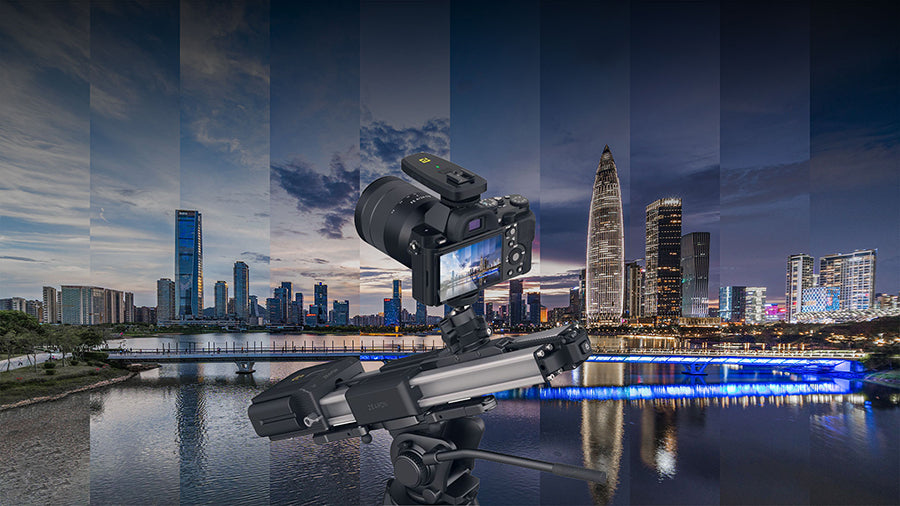
Flexible Dual Control of Signal Synchronization
Timelapse trigger brings a brand-new experience for rail slider shooting timelapse scenes, breaks through the limitation that "the rail slider can only control the camera in one direction" in this scene, and achieves "camera controlling rail slider" through the transmission of timelapse trigger signals, so that the camera becomes the dominant device, and the parameters can be adjusted more freely to meet the requirements of more timelapse scenes.
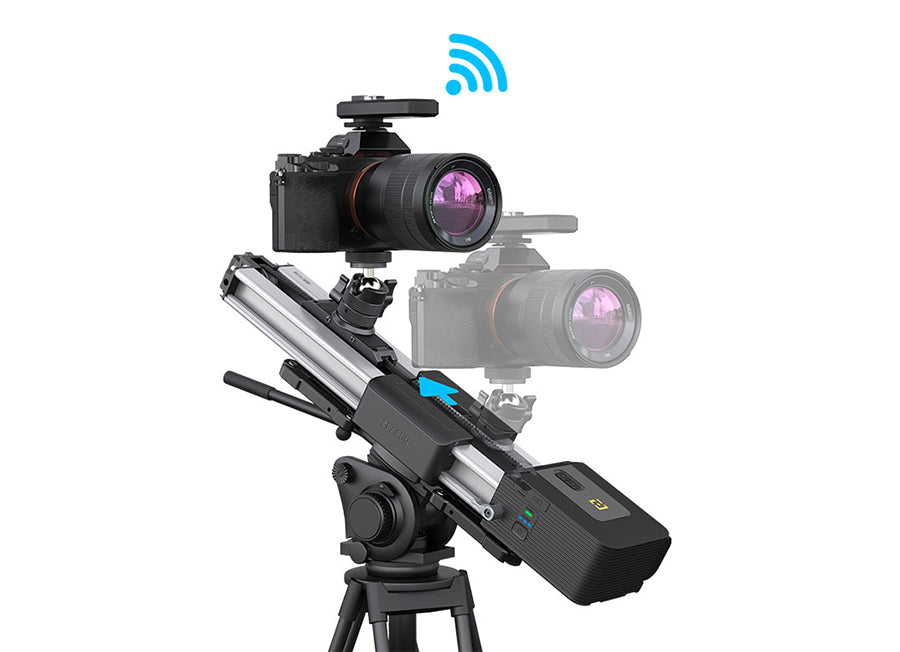
Improvement and Upgrade of ZEAPON Timelapse Shooting System
With the Micro 2 series motorized rail slider and timelapse trigger, as well as the new upgrade of the App, ZEAPON brings a set of flexible, portable and stable shooting system for timelapse photography players, and creates the most complete timelapse shooting experience.
The functions of "Intelligent Timelapse", "Custom Timelapse" and "Camera Mode" are all available.
Even the more difficult day to night moving timelapse can be easily mastered. Through this system, the art of time passing can be controlled, and new users can become timelapse masters.
* The timelapse trigger can only be adapted for using with Micro 2 series motorized rail slider;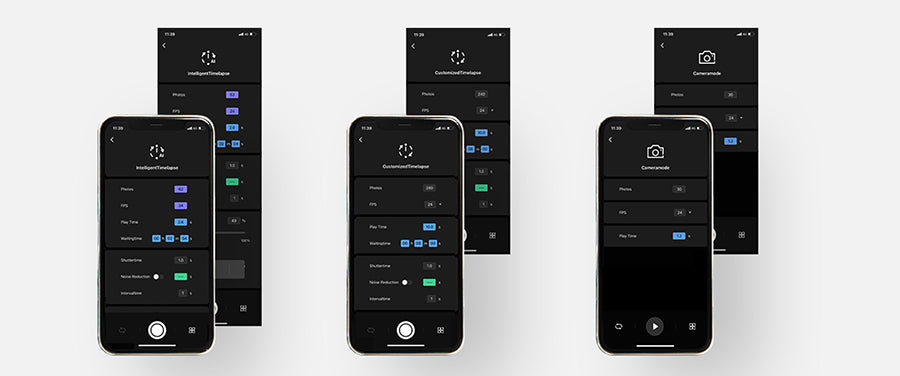
Refuse Complexity and Pursue Simplicity, Two Connection Methods
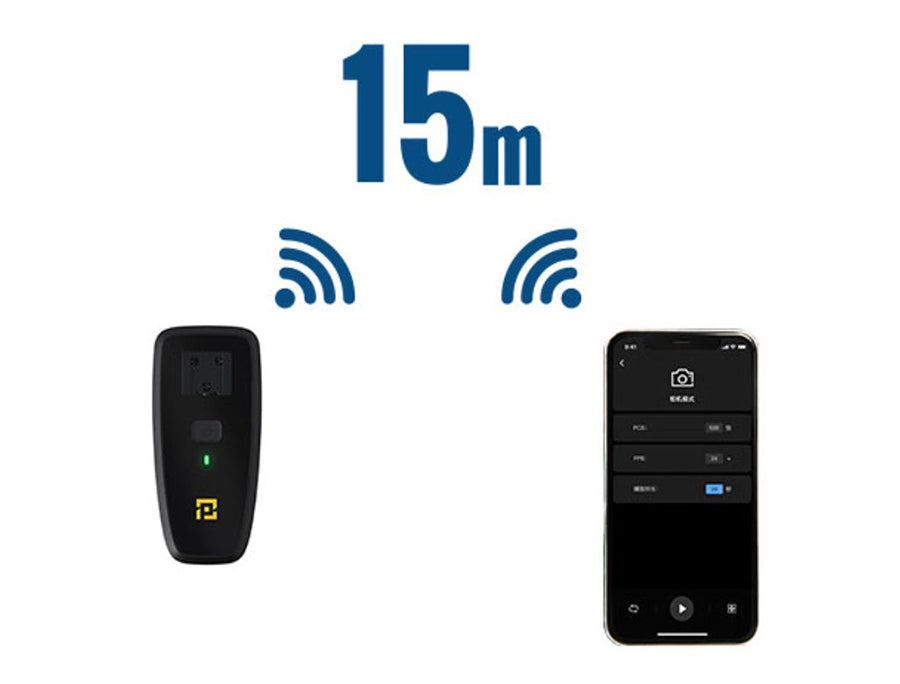
Wireless
The rail slider is controlled by the camera in Camera mode, and the rail slider and timelapse trigger are connected through mobile phone Bluetooth (App) at the same time. The transmission distance is up to 15m, achieving response without delay, which is stable and reliable;A signal multiplexing system is designed to ensure that the timelapse trigger is still on standby for the next command at any time when unexpected situations occur such as camera signal missing, so as to maintain the normal operation of the entire system;
* When using Bluetooth connection, avoid leaving the mobile phone 15m away from the timelapse trigger, and avoid the presence of large obstacles between the mobile phone and the timelapse trigger, so as not to cause signal disconnection or occlusion and affect shooting;
* If the signal is interrupted when the mobile phone got away, the camera is still shooting, and the rail slider stops running due to signal interruption, you need to press the camera's shooting button again to enable the camera to start its own timelapse photography function, so as to ensure that the device completes the original set motion path.
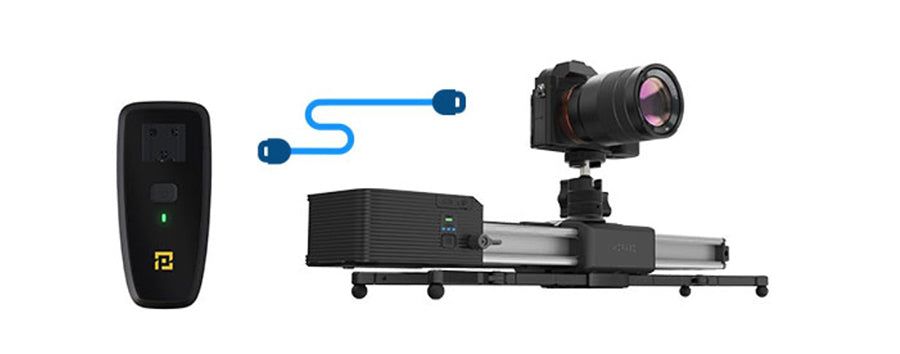
Wired
The camera is controlled by the rail slider in the mode of Intelligent Timelapse and Custom Timelapse, and the camera can be directly connected to the timelapse trigger through the shutter cable instead of connecting the rail slider. Therefore, the situation of the shutter cable pulling caused by the moving of the rail slider is effectively avoided, there is no need to worry about the influence of the shaking of the equipment on the shooting effect, and the shooting process is more flexible.
Offline Operation
ZEAPON Lab APP can be switched to run in the background, there is no need to prepare more mobile phones, and it does not affect watching videos and replying messages during the shooting intervals.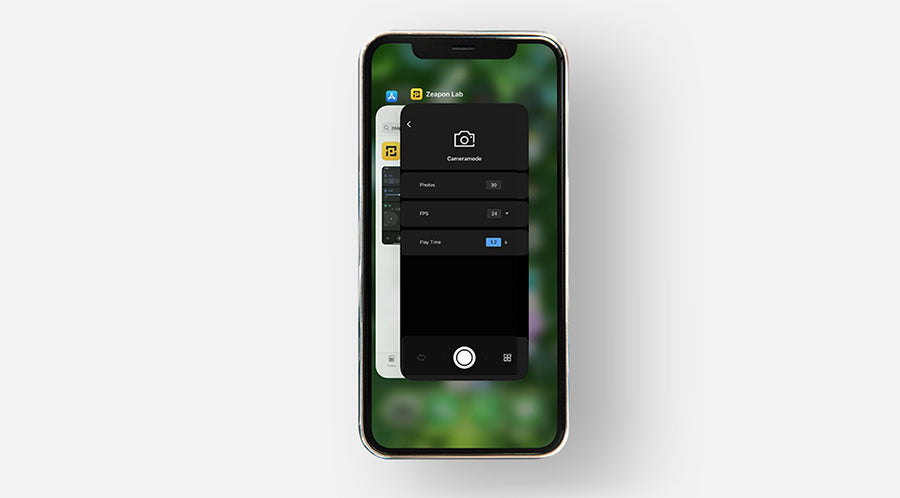
Palm-sized and Portable
The timelapse trigger is powerful, but only palm-sized,
it does not take up space in the bag, and it is easy to carry for traveling.
Long-Lasting Battery Life and No Fear of Danger
With built-in polymer lithium battery, the battery life in continuous operation is up to 14 hours.
It can also be powered by a rechargeable battery at the same time,
easily coping with the extreme environmental conditions of timelapse photography such as starlapse, galaxy, sunrise and moonset.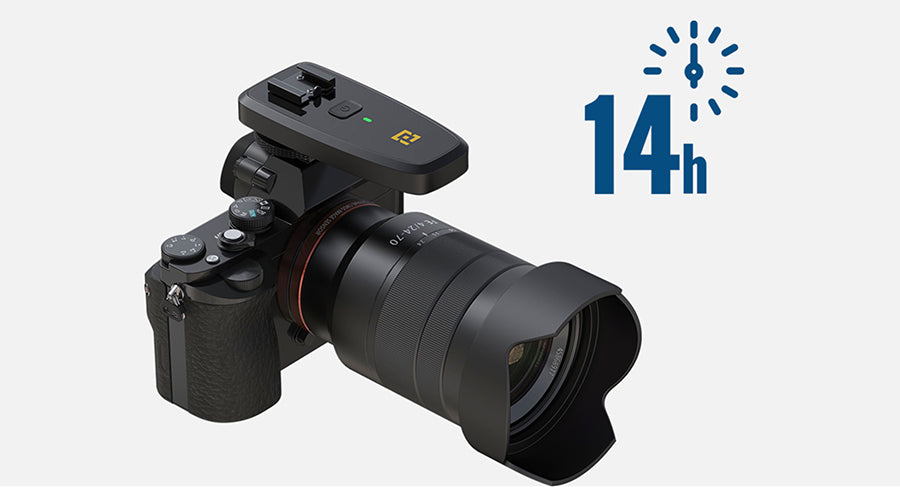
Flexible Installation and Free Extension
The timelapse trigger is equipped with extended cold shoe port, which can fix microphones,
flashlights and other equipment according to different shooting scenes, and fully meets the requirements of various equipment erection.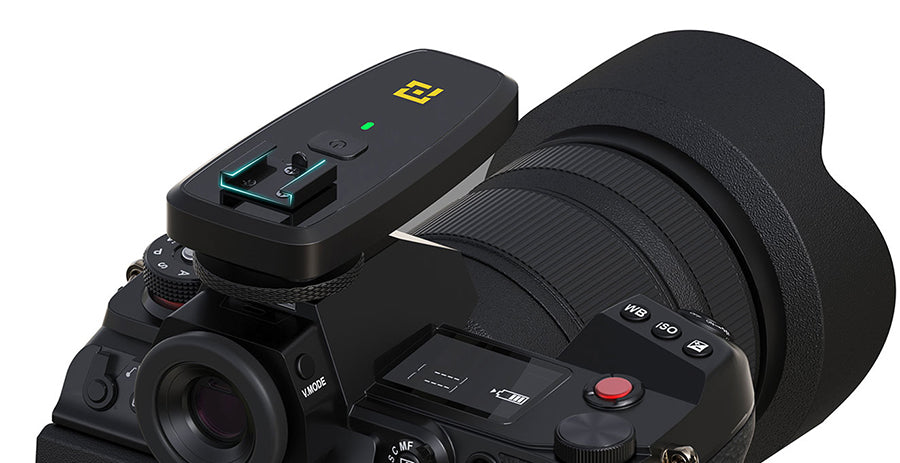
Camera Compatibility List:
Sony:
ILCE-6400 / ILCE-7M3 / ILCE-7RM4A / ILCE-7SM3 / ILCE 1 / ILCE-7RM3A / ILCE 7CL / DSC-RX100M7 / ZV-1 / ILCE-9M2 / ILCE-6600 / ILCE-6600m / ILCE-6400L / ILCE-6400M / ILCE-7RM4 / ILCE-7M3K / ILCE-7C / ILCE-9
Canon:
EOS 6DMark Ⅱ / EOS R6 / EOS R5 / EOS M6 Mark II / EOS 7D Mark II / EOS 90D / EOS 5D Mark IV / EOS 90D / EOS RP / EOS 77D / EOS 5DS / EOS 5DSR / EOS 80D
Nikon:
D7500 / D780 / D850 / D6 / D750 / D610 / D5600 / D500 / Z7Ⅱ / Z6Ⅱ / Z5 / Z50 / Z6 / Z7 / D5 / DF / D810A / D810 / D7200 / D5300
Lumix:
DC-S5GK-K / DC-S5KGK-K / DC-GH5SGK / DC-GH5GK / DC-S1KGK-K / DC-S1HGK-K / DC-S1RGK-K / DC-G95GK / DMC-GH4GK / DMC-G85GK / DC-S1MGK-K / DC-S1GK-K / DC-FZ10002GK
Fujifilm:
X-S10 / X-T4 / X-T30 / X-A7 / X-T3 / x-pro3 / X100V / X100F / XT200 / X-H1 / X-Pro2 / X-T2 / X-T100 / X-E3 / X-T1 / X-E4 / GFX 50R / GFX 50s / GFX 100 / GFX 100S
Nikon Z6 II Overview
Key Features
- 24.5MP FX-Format BSI CMOS Sensor
- Dual EXPEED 6 Image Processors
- UHD 4K30 Video; N-Log & 10-Bit HDMI Out
- 14 fps Cont. Shooting, ISO 100-51200
- 273-Point Phase-Detect AF System
- 3.6m-Dot OLED Electronic Viewfinder
- 3.2" 2.1m-Dot Tilting Touchscreen LCD
- 5-Axis In-Body Vibration Reduction
- Dual Memory Card Slots
- NIKKOR Z 24-70mm f/4 S Lens
More speed, more versatility, more performance, the Nikon Z6 II is an updated take on the all-rounder mirrorless camera designed for high-end photo and video applications. Despite the wealth of upgrades, the Z6 II retains its familiar form factor and prized image quality to benefit working multimedia image-makers.
Revolving around a 24.5MP BSI CMOS sensor and dual EXPEED 6 image processors, the Z6 II is characterized by an increased buffer depth and faster continuous shooting rate, up to 14 fps with single-point AF or 12 fps shooting in other focusing modes. Video recording at UHD 4K 30p is possible, or up to FHD 120p for slow-motion output, and external recording gains 10-bit out along with N-Log and HLG (HDR) support. The sensor also suits working in a variety of lighting conditions, with sensitivity from ISO 100-51200, and in-body 5-axis Vibration Reduction reduces the appearance of camera shake for sharper handheld shooting. Additionally, the sensor also incorporates a 273-point phase-detection AF system, which now supports Eye-Detect AF in Wide-Area AF modes and during movie recording, and permits focusing in low-light down to -4.5 EV.
Balancing the imaging, the Z6 II retains its overall physical design, however it has been updated with a new dual memory card slot interface to hold one CFexpress Type B card and one SD UHS-II card for more flexible storage. Both a high-res 3.6m-dot OLED EVF and rear 3.2" 2.1m-dot tilting touchscreen LCD lend versatility to image composition and playback, and SnapBridge wireless connectivity can be used for remote camera control, image sharing to a mobile device, and even over-the-air firmware updates.
Firmware version 1.10 unlocks UHD 4K recording at 60p and 50p frame rates, enables raw video output to Blackmagic Design Video Assist external recorders, and improves eye-detection performance when using Auto-Area AF and Wide-Area AF modes.
Second Generation Z
Improving upon their initial efforts, Nikon has revised the Z6 platform to offer more speed, faster processing, and greater versatility without sacrificing the beloved qualities of the original camera.
- Dual EXPEED 6 image processors offer increased buffer performance, a faster 14 fps continuous shooting rate, and noticeably reduced blackout times in the viewfinder.
- Updated autofocus now includes Eye and Face Detection for both humans and animals in the Wide-Area AF mode, for both photo and video recording.
- Timed long exposure shooting is now possible for up to 900 seconds (15 minutes) without the need of an external remote.
- Dual memory card slots offer more flexible file storage capabilities; one CFexpress Type B and one SD UHS-II slot permit overflow, segregated, and repetitive saving options.
- USB Type-C port permits in-camera charging or continuous power for on-the-go charging or extended shooting times.
- The rotation direction of the focus ring on lenses can be switched to suit one's familiarity.
- Support for HDR (HLG) mode when recording externally gives instant HDR-suitable video files for immediate playback. N-Log is also available for enhanced control during post-production and grading, too.
- Future firmware update will add UHD 4K 60p recording, in addition to the current 30p frame rate.
- Eligible for an optional ProRes RAW upgrade, enabling the camera to output ProRes RAW footage to a compatible Atomos external recorder. This upgrade provides greater color grading flexibility with the ProRes codec along with the ability to output uncompressed 12-bit raw footage over HDMI. This upgrade will be available in early 2021.
- The SnapBridge wireless connectivity can be used to update the camera's firmware, instead of relying on a memory card-based system of updating.
- Updated creative shooting modes include Multiple Exposure, 20 different Picture Control settings, and in-camera Timelapse recording. There is also a Focus Shift mode for recording up to 300 sequential frames with the focus position shifted between exposures for focus stacking applications.
- Compatible with optional MB-N11 Power Battery Pack for additional battery life and improved handling.
24.5MP FX-Format BSI CMOS Sensor and Dual EXPEED 6 Processors
A 24.5MP BSI CMOS sensor is used for all-around shooting, impressive low-light quality, and fast readout speeds to benefit continuous shooting, movies, and time-lapse recording. The back-illuminated design of the sensor affords noticeably clean high-sensitivity output for reduced noise when working at high ISO values, up to a native ISO 51200, as well as vivid and smooth quality at sensitivities as low as ISO 100. Benefitting the sensor are dual EXPEED 6 image processors, which affords a wealth of speed throughout the camera system, including the ability to shoot continuously at 14 fps for up to 124 consecutive frames.
UHD 4K Video Recording
Utilizing the sensor and processor attributes for more than just still imagery, the Z6 II is also a more-than-capable multimedia camera. UHD 4K video recording is possible with full pixel readout up to 30p and Full HD 1080p video recording is also supported at up to 120p for slow motion playback. Video files can be saved to the in-camera memory cards or as an uncompressed file to an optional external recorder via HDMI out.
Advanced video functionalities have been added with the Z6 II, including the N-Log gamma for capturing flat-looking footage that maximizes dynamic range and HLG (HDR) for recording HDR-ready footage. Other additions are the ability to output high-quality 10-bit data over HDMI and an Electronic VR function for smooth handheld shooting. Focus Peaking can be used to benefit manual focus control and a Zebra Stripes option is also available to help detect over-exposed areas within the frame. Audio recording can be handled using the built-in stereo microphone or an optional external mic can be added via the 3.5mm stereo jack for greater control over quality, and live monitoring is possible via the headphone jack.
Firmware version 1.10 unlocks UHD 4K recording at 60p and 50p frame rates and enables raw video output to Blackmagic Design Video Assist external recorders, and also improves eye-detection performance Auto-Area AF and Wide-Area AF modes.
273-Point Phase-Detect AF System
Located on the sensor is an array of 273 phase-detect autofocus points covering 90% of the image area both vertically and horizontally. This provides fast and accurate focusing for both stills and video and with a wide coverage area, subject tracking will work out to near the edges of the frame. Hybrid AF is available for video, which will automatically switch between phase- and contrast-detect systems to provide smooth focus during shooting. Additionally, the latest NIKKOR Z lenses are optimized for silent operation.
Vibration Reduction
In-body 5-axis sensor-shift Vibration Reduction compensates for up to 5 stops of camera shake regardless of the Z-type lens being used. This system also works with adapted F-mount lenses, when using the optional FTZ Adapter, where 3-axis stabilization is used.
Body Design
- A large 3.2" 2.1m-dot LCD screen is available for bright, clear, and vivid image playback and live view shooting. The screen has a tilting design to benefit working from both high and low angles, and it is also a touchscreen for more intuitive operation, navigation, and settings control.
- A 3.6m-dot OLED electronic finder is present for comfortable eye-level viewing. It has a high 0.80x magnification and uses NIKKOR optics to guarantee a sharp, clear image. The finder also has a fluorine coating for easier cleaning.
- The top panel of the Z6 II is configured with a dot-matrix OLED. This low-energy display provides quick access to important camera settings.
- Configured with one CFexpress Type B/XQD memory card slot and one UHS-II SD card slot, flexible file storage is possible with the option to use repetitive, overflow, or segregated storage methods.
- A robust magnesium alloy chassis is both dust- and weather-resistant to benefit working in harsh climates and inclement conditions.
- The ergonomic grip and overall form factor is shaped to benefit handling for extended periods of time and is further accentuated by an anti-slip material and a joystick for seamless settings and focus point selection.
- Built-in SnapBridge connectivity to enable seamless transfer of low-resolution imagery as well as remote shooting capabilities. BLE (Bluetooth Low Energy) and Wi-Fi enables communication between the camera and a smart device and, additionally, the mobile device can remotely trigger the shutter and display a live view image from the camera to enable working from a distance. Additionally, SnapBridge can also be used as an easier method of updating the camera's firmware.
NIKKOR Z 24-70mm f/4 S Lens
Included with the camera body is the standard zoom NIKKOR Z 24-70mm f/4 S lens, which covers a wide-angle to portrait-length range and features a constant f/4 maximum aperture. The optical design incorporates one aspherical element as well as a unique aspherical extra-low dispersion element; both of which help to greatly reduce a variety of aberrations and distortion for high sharpness and accurate color rendering. A Nano Crystal Coating is also used to control flare and ghosting for increased contrast in strong lighting conditions. Suiting both photo and video applications, a stepping AF motor is also featured for smooth, near-silent autofocus performance.
Z6 II Firmware Ver. 1.30 (Released 10/19/2021)
- Portrait Impression Balance items have been added to the PHOTO SHOOTING MENU and MOVIE SHOOTING MENU
- The monitor now shows the shooting display while tilted when On is selected for Image review in the PLAYBACK MENU
- Voice memo has been added to the options available for Custom Setting f2 (Custom controls) > Movie record button in the CUSTOM SETTING MENU. In this role, the movie-record button can be used during playback to record and play voice memos up to 60 seconds long.
- Custom Setting f4 (Aperture lock) in the CUSTOM SETTING MENU now available when an FTZ mount adapter is attached
- The flash-ready light on SB-5000 flash units will light if a WR-R10 or WR-R11b is used for wireless remote flash photography
- Fixed: Focus would normally remain locked if the AF-ON button was kept pressed while the shutter-release button was used to take a series of pictures, the camera would refocus without input from the AF-ON button
- Fixed: Custom Setting a6 (AF activation) in the CUSTOM SETTING MENU set to AF-ON only with Enable selected for Out-of-focus release
- Fixed: Continuous L or Continuous H selected for Release mode
- Fixed: Single AF selected for Focus mode
- Fixed: Single-point AF selected for AF-area mode
Nikon Z6 Kit 24-70mm F4 + FT Z Ring Adaptor (Black)
Key Features
- 24.5MP FX-format BSI CMOS Sensor
- EXPEED 6 Image Processing Engine
- UHD 4K30 Video; N-Log & 10-Bit HDMI Out
- 273-Point Phase-Detect AF System
Nikon Z6 Overview
Nikon Z 6 Mirrorless Digital Camera with 24-70mm Lens
Part of Nikon's next step in their imaging journey, the Z 6 Mirrorless Camera is positioned as the "all-arounder" within the new Z System. Beginning with the Z Mount itself, a large-diameter design with a short 16mm flange distance allows Nikon to create compact, yet powerful cameras and develop more advanced optics. The Z 6 is among the first in the series, and features a high-performing FX-format 24.5MP BSI CMOS sensor and the EXPEED 6 Image Processing Engine delivering outstanding image quality and speed with a native sensitivity Range of ISO 100-51200.
On the sensor you will find an advanced phase-detect autofocus system using 273 points covering 90% of the image area, and the sensor features 5-axis Vibration Reduction technology for stabilized photos and video regardless of the lens used. This advanced hybrid AF system will also benefit video. The Z 6 features UHD 4K recording at up to 30p and can use the N-Log gamma profile along with the camera's 10-bit HDMI output to create cinema-quality video.
As with many mirrorless systems, the Z Series boasts a much more compact form factor than its DSLR counterparts. The Z 6 is no exception with its slimmed down design and lighter build, though it maintains the weather sealing and ergonomics for which Nikon is known. The camera features multiple displays and screens for ease of use, including a 0.80x 3.6m-dot EVF with NIKKOR optics and a Fluorine coating, ensuring clear viewing. The rear of the camera is equipped with a 3.2" 2.1m-dot tilting touchscreen LCD while the top offers a dot-matrix OLED for quickly checking settings. Additionally, the body is equipped with both Wi-Fi and Bluetooth.
Nikon Z System
Introducing the Z mount, Nikon's full-frame mirrorless system promises to deliver class-leading image quality and optics in a compact form factor. The Z mount itself makes much of this possible with a 17% larger inner diameter than the F mount, enabling the use of more advanced optics and lens designs, including ultra-fast f/0.95 options. for minimizing camera and lens size, the Z mount features a 65% shorter flange distance, measuring just 16mm, which allows for dramatically slimmed down body designs. The larger mount also supports faster and larger-volume communications between the body and lens to improve overall performance throughout the system.
24.5MP FX-format BSI CMOS Sensor and EXPEED 6 Processor
A 24.5MP BSI CMOS sensor is used for all-around shooting, impressive low-light quality, and fast readout speeds to benefit continuous shooting, movies, and time-lapse recording. The back-illuminated design of the sensor affords noticeably cleaner high-sensitivity output for reduced noise when working at high ISO values, up to a native ISO 51200, as well as vivid and smooth quality at sensitivities as low as ISO 100. Benefitting the sensor is the apt EXPEED 6 image processor, which affords a wealth of speed throughout the camera system, including the ability to shoot continuously at 12 fps in raw.
4K UHD Video Recording
Utilizing the sensor and processor attributes for more than just still imagery, the Z 6 is also a more-than-capable multimedia camera. Video recording is possible at UHD 4K (3840 x 2160) using either the full-frame area or a DX crop area in 30p, 25, or 24p frame rates. Full HD 1080p video recording is also supported at up to 120p for slow motion playback, and video files can be saved to the in-camera memory cards or as an uncompressed file to an optional external recorder via HDMI out.
Advanced video functionalities have been added with the Z 6. This includes the N-Log gamma for capturing flat-looking footage that maximizes dynamic Range. Other additions are the ability to output high-quality 10-bit data over HDMI and an Electronic VR function for smooth handheld shooting. Focus Peaking can be used to benefit manual focus control and a Zebra Stripes option is also available to help detect over-exposed areas within the frame. Audio recording can be handled using the built-in stereo microphone or an optional external mic can be added via the 3.5mm stereo jack for greater control over quality, and live monitoring is possible via the headphone jack.
Further complementing video capabilities, the Z 6 is eligible for an optional ProRes RAW upgrade, enabling the camera to output ProRes RAW footage to a compatible Atomos external recorder. This upgrade provides greater color grading flexibility with the ProRes codec along with the ability to output uncompressed 12-bit raw footage over HDMI. This upgrade requires sending the camera to Nikon's Service Department for installation.
273-Point Phase-Detect AF System
Located on the sensor is an array of 273 phase-detect autofocus points covering 90% of the image area both vertically and horizontally. This provides fast and accurate focusing for both stills and video and with a wide coverage area, subject tracking will work out to near the edges of the frame. Hybrid AF is available for video, which will automatically switch between phase- and contrast-detect systems to provide smooth focus during shooting. Additionally, the latest NIKKOR Z lenses are optimized for silent operation.
Body Design
- Built-in to the body is a 5-axis sensor-shift Vibration Reduction mechanism for up to 5 stops of stabilization regardless of the lens used. This system also works with adapted lenses when using the optional FTZ Adapter where 3-axis stabilization is used.
- A large 3.2" 2.1m-dot LCD screen is available for bright, clear, and vivid image playback and live view shooting. The screen has a tilting design to benefit working from both high and low angles, and it is also a touchscreen for more intuitive operation, navigation, and settings control.
- A 3.6m-dot electronic finder is present for comfortable eye-level viewing. It has a high 0.80x magnification and uses NIKKOR optics to guarantee a sharp, clear image. The finder also has a Fluorine coating for easier cleaning.
- The top panel of the Z 6 is configured with a dot-matrix OLED. This low-energy display provides quick access to important camera settings.
- Configured with one CFexpress Type B/XQD memory card slot, the camera will be able to quickly save photo and video files.
- A robust magnesium-alloy chassis is both dust- and weather-resistant to benefit working in harsh climates and inclement conditions.
- The ergonomic grip and overall form factor is shaped to benefit handling for extended periods of time and is further accentuated by an anti-slip material and a joystick for seamless settings and focus point Selection.
- Built-in SnapBridge connectivity to enable seamless transfer of low-resolution imagery as well as remote shooting capabilities. BLE (Bluetooth Low Energy) and Wi-Fi enables communication between the camera and a smart device and, additionally, the mobile device can remotely trigger the shutter and display a live view image from the camera to enable working from a distance.
- Included EN-EL15b rechargeable lithium-ion battery provides approximately 310 shots per charge, and in-camera charging is supported. This camera is also compatible with EN-EL15 and EN-EL15a batteries, however do not support in-camera charging.
Ã
NIKKOR Z 24-70mm f/4 S Lens
Included with the camera body is the standard zoom NIKKOR Z 24-70mm f/4 S lens, which covers a wide-angle to portrait-length Range and features a constant f/4 maximum aperture. The optical design incorporates one aspherical element as well as a unique aspherical extra-low dispersion element; both of which help to greatly reduce a variety of aberrations and distortion for high sharpness and accurate color rendering. A Nano Crystal Coating is also used to control flare and ghosting for increased contrast in strong lighting conditions. Suiting both photo and video applications, a stepping AF motor is also featured for smooth, near-silent autofocus performance.
Ã
Nikon FTZ Mount Adapter
Enabling the use of nearly any Nikon F-mount lens on Z-mount mirrorless camera bodies, the FTZ Mount Adapter is a sophisticated means for expanding the Range of usable lenses. While compatible with approximately 360 distinct F-mount lenses, this adapter is especially ideal for use with over 90 E, G, and D-type lenses, where it fully maintains autofocus and auto-exposure capabilities for seamless use of the SLR lenses on the mirrorless body. The adapter, which is built from magnesium alloy and is weather-sealed, also incorporates a 1/4"-20 mount on the base to provide a more balanced means for working on a tripod with longer, heavier lenses.
Lens Compatibility
Full AF/AE supported when using:
- AF-S type G/D/E lenses
- AF-P type G/E lenses
- AF-I type D lenses
- AF-S / AF-I teleconverters
Nikon Z6 Mirrorless Body Only + FT Z Ring Adaptor (Black)
Key Features
- 24.5MP FX-format BSI CMOS Sensor
- EXPEED 6 Image Processing Engine
- UHD 4K30 Video; N-Log & 10-Bit HDMI Out
- 273-Point Phase-Detect AF System
Nikon Z6 Overview
Part of Nikon's next step in their imaging journey, the Z 6 Mirrorless Camera is positioned as the "all-arounder" within the new Z System. Beginning with the Z Mount itself, a large-diameter design with a short 16mm flange distance allows Nikon to create compact, yet powerful cameras and develop more advanced optics. The Z 6 is among the first in the series, and features a high-performing FX-format 24.5MP BSI CMOS sensor and the EXPEED 6 Image Processing Engine delivering outstanding image quality and speed with a native sensitivity Range of ISO 100-51200.
On the sensor you will find an advanced phase-detect autofocus system using 273 points covering 90% of the image area, and the sensor features 5-axis Vibration Reduction technology for stabilized photos and video regardless of the lens used. This advanced hybrid AF system will also benefit video. The Z 6 features UHD 4K recording at up to 30p and can use the N-Log gamma profile along with the camera's 10-bit HDMI output to create cinema-quality video.
As with many mirrorless systems, the Z Series boasts a much more compact form factor than its DSLR counterparts. The Z 6 is no exception with its slimmed down design and lighter build, though it maintains the weather sealing and ergonomics for which Nikon is known. The camera features multiple displays and screens for ease of use, including a 0.80x 3.6m-dot EVF with NIKKOR optics and a Fluorine coating, ensuring clear viewing. The rear of the camera is equipped with a 3.2" 2.1m-dot tilting touchscreen LCD while the top offers a dot-matrix OLED for quickly checking settings. Additionally, the body is equipped with both Wi-Fi and Bluetooth.
Nikon Z System
Introducing the Z mount, Nikon's full-frame mirrorless system promises to deliver class-leading image quality and optics in a compact form factor. The Z mount itself makes much of this possible with a 17% larger inner diameter than the F mount, enabling the use of more advanced optics and lens designs, including ultra-fast f/0.95 options. for minimizing camera and lens size, the Z mount features a 65% shorter flange distance, measuring just 16mm, which allows for dramatically slimmed down body designs. The larger mount also supports faster and larger-volume communications between the body and lens to improve overall performance throughout the system.
24.5MP FX-format BSI CMOS Sensor and EXPEED 6 Processor
A 24.5MP BSI CMOS sensor is used for all-around shooting, impressive low-light quality, and fast readout speeds to benefit continuous shooting, movies, and time-lapse recording. The back-illuminated design of the sensor affords noticeably cleaner high-sensitivity output for reduced noise when working at high ISO values, up to a native ISO 51200, as well as vivid and smooth quality at sensitivities as low as ISO 100. Benefitting the sensor is the apt EXPEED 6 image processor, which affords a wealth of speed throughout the camera system, including the ability to shoot continuously at 12 fps in raw.
4K UHD Video Recording
Utilizing the sensor and processor attributes for more than just still imagery, the Z 6 is also a more-than-capable multimedia camera. Video recording is possible at UHD 4K (3840 x 2160) using either the full-frame area or a DX crop area in 30p, 25, or 24p frame rates. Full HD 1080p video recording is also supported at up to 120p for slow motion playback, and video files can be saved to the in-camera memory cards or as an uncompressed file to an optional external recorder via HDMI out.
Advanced video functionalities have been added with the Z 6. This includes the N-Log gamma for capturing flat-looking footage that maximizes dynamic Range. Other additions are the ability to output high-quality 10-bit data over HDMI and an Electronic VR function for smooth handheld shooting. Focus Peaking can be used to benefit manual focus control and a Zebra Stripes option is also available to help detect over-exposed areas within the frame. Audio recording can be handled using the built-in stereo microphone or an optional external mic can be added via the 3.5mm stereo jack for greater control over quality, and live monitoring is possible via the headphone jack.
Further complementing video capabilities, the Z 6 is eligible for an optional ProRes RAW upgrade, enabling the camera to output ProRes RAW footage to a compatible Atomos external recorder. This upgrade provides greater color grading flexibility with the ProRes codec along with the ability to output uncompressed 12-bit raw footage over HDMI. This upgrade requires sending the camera to Nikon's Service Department for installation.
273-Point Phase-Detect AF System
Located on the sensor is an array of 273 phase-detect autofocus points covering 90% of the image area both vertically and horizontally. This provides fast and accurate focusing for both stills and video and with a wide coverage area, subject tracking will work out to near the edges of the frame. Hybrid AF is available for video, which will automatically switch between phase- and contrast-detect systems to provide smooth focus during shooting. Additionally, the latest NIKKOR Z lenses are optimized for silent operation.
Body Design
- Built-in to the body is a 5-axis sensor-shift Vibration Reduction mechanism for up to 5 stops of stabilization regardless of the lens used. This system also works with adapted lenses when using the optional FTZ Adapter where 3-axis stabilization is used.
- A large 3.2" 2.1m-dot LCD screen is available for bright, clear, and vivid image playback and live view shooting. The screen has a tilting design to benefit working from both high and low angles, and it is also a touchscreen for more intuitive operation, navigation, and settings control.
- A 3.6m-dot electronic finder is present for comfortable eye-level viewing. It has a high 0.80x magnification and uses NIKKOR optics to guarantee a sharp, clear image. The finder also has a Fluorine coating for easier cleaning.
- The top panel of the Z 6 is configured with a dot-matrix OLED. This low-energy display provides quick access to important camera settings.
- Configured with one CFexpress Type B/XQD memory card slot, the camera will be able to quickly save photo and video files.
- A robust magnesium-alloy chassis is both dust- and weather-resistant to benefit working in harsh climates and inclement conditions.
- The ergonomic grip and overall form factor is shaped to benefit handling for extended periods of time and is further accentuated by an anti-slip material and a joystick for seamless settings and focus point Selection.
- Built-in SnapBridge connectivity to enable seamless transfer of low-resolution imagery as well as remote shooting capabilities. BLE (Bluetooth Low Energy) and Wi-Fi enables communication between the camera and a smart device and, additionally, the mobile device can remotely trigger the shutter and display a live view image from the camera to enable working from a distance.
- Included EN-EL15b rechargeable lithium-ion battery provides approximately 310 shots per charge, and in-camera charging is supported. This camera is also compatible with EN-EL15 and EN-EL15a batteries, however do not support in-camera charging.
Â
Nikon FTZ Mount Adapter
Enabling the use of nearly any Nikon F-mount lens on Z-mount mirrorless camera bodies, the FTZ Mount Adapter is a sophisticated means for expanding the Range of usable lenses. While compatible with approximately 360 distinct F-mount lenses, this adapter is especially ideal for use with over 90 E, G, and D-type lenses, where it fully maintains autofocus and auto-exposure capabilities for seamless use of the SLR lenses on the mirrorless body. The adapter, which is built from magnesium alloy and is weather-sealed, also incorporates a 1/4"-20 mount on the base to provide a more balanced means for working on a tripod with longer, heavier lenses.
Lens Compatibility
Full AF/AE supported when using:
- AF-S type G/D/E lenses
- AF-P type G/E lenses
- AF-I type D lenses
- AF-S / AF-I teleconverters
Nikon Z6 III Overview
Key Features
- 24.5MP Partially-Stacked CMOS Sensor
- EXPEED 7 Image Processor
- 6K 60p N-RAW, 6K 30p ProRes RAW
- 4K 120p, Full HD 240p Slow Motion Video
- Up to 20 fps Raw, 60 fps JPEG Shooting
- Blackout-Free, 5760k-Dot EVF
- 493-Point AF, AI-Based Subject Detection
- 3.2" 4-Axis Tilting Touchscreen LCD
- CFx Type B & SD Memory Card Slots
- NIKKOR Z 24-120mm f4 S Lens
Sporting a new and inspired partially-stacked sensor design, the Nikon Z6 III Mirrorless Camera unlocks a number of flagship-level upgrades for this mid-range camera, including faster and more precise autofocus, professional-level 6K internal raw video, pre-capture at up to 120 fps, and a smooth, bright, colorful EVF. Taken together, these upgrades make this mirrorless monster an ideal choice for aspiring professionals in search of an all-around, affordable camera.
Newly Designed Sensor and Flagship Processing

24.5MP Partially-Stacked CMOS Sensor
The Z6 III is Nikon's first camera to to feature a partially stacked sensor design for faster scans and readouts than its predecessor, as well as reducing rolling shutter. Additionally, this sensor design unlocks many of the flagship-level features in the camera, like faster autofocus, a smoother EVF experience, faster continuous shooting speeds, and higher frame rates when shooting video.
EXPEED 7 Image Processor
Complementing the sensor is the EXPEED 7 processing engine, found in the top-of-the-line Z8 and Z9 mirrorless cameras an which offers speeds approximately 10x faster than the Z6II. This engine works in conjunction with the partially-stacked sensor design to realize impressively fast AF speeds, burst shooting rates, a high buffer capacity, fluid video performance, and quick all-around handling.

- Top continuous shooting speeds of 20 fps when shooting in raw, up to 60 fps when shooting in full-frame JPEG, and 120 fps when shooting JPEGs using a DX crop, with all rates supporting full AF/AE performance.
- Able to buffer over 1000 images in a burst when using the electronic shutter, meaning image sequences can be recorded for approximately 50 seconds continuously.

- Pre-Release Capture at up to 120 fps helps make decisive moment shots easier by recording frames in a burst for up to a second prior to actually releasing the shutter. When this feature is activated, burst shooting will commence when the shutter is half-pressed and the buffer will retain up to 4 seconds' worth of frames after fully pressing the shutter.
- Electronic shutter affords a top shutter speed of 1/16,000 sec for working in the brightest conditions with wider apertures.
- Partially-stacked sensor design reduces rolling shutter distortion so fast-moving subjects, like a golf club, tennis racket, or baseball bat, do not appear distorted when working with shutter speeds up to 1/16,000 sec.
- AF calculations are done at a 120 fps rate to keep up with fast continuous shooting speeds.
Fast and Intelligent AF

493-Point Phase-Detection AF
Covering the full sensor area, the Z6 III's flagship EXPEED 7 processor unlocks Nikon's flagship 493-point phase-detection AF system to realize fast and accurate focusing performance. This system is benefitted by the high-speed communication of the Z interface along with the speed of the sensor that enables AF readings to occur at up to 120 fps.

This focusing system also supports working in low-light conditions with a Starlight mode that permits focusing down to -10 EV to greatly benefit astrophotography, concert, and other nighttime shooting applications. Featuring the highest native ISO in a Z-series camera at ISO 64000, the autofocus is also useful for working in difficult lighting conditions. The Backlit AF function uses separate pixels on the sensor that allows these areas to intentionally overexpose for focusing accuracy purposes without impacting the actual exposure of the recorded image.
A mainstay focusing mode in DSLRs, which debuted for mirrorless with the Z9, the Z6 III also includes 3D Tracking AF that pairs with subject detection to lock onto fast, erratically moving subjects that move parallel and perpendicular to the camera. Additionally, there are three Dynamic-Area AF modes, with a range of focus area sizes, for capturing a broad variety of moving subject types.

Subject Detection with Deep Learning Technology
Utilizing inherited algorithms and deep learning technology from the Z9, including sophisticated Subject Detection, the Z6 III can recognize a variety of distinct subject types, ranging from humans to animals to airplanes to bicycles. When working in Auto-Area AF, these subjects will automatically be detected, focused on, and tracked to ensure sharp focus when the subject is moving across the frame.
Eye-Detection AF, specifically, has been tuned for improved accuracy and refined recognition of eyes in the scene and can also be used in conjunction with custom Wide-Area AF for different subject shapes and sizes.

More Beautiful Portraits
Perfect for portraits, the Z6 III improves on the partially-stacked sensor's inherent capabilities with a series of processing tools and shooting functions to improve portraits:
- Portrait mode processes portraits for skin with natural texture and a rounded feel
- Rich Tone Portrait mode, a picture mode that produces more vivid results while capturing details of the subject's complexion and avoiding loss of detail in the highlights
- Flat Monochrome mode features gentle gradations from highlights to shadows, producing soft monochrome portraits
- Deep Tone Monochrome mode chooses slightly darker tones in the range from shadows to mid-tones, with brightness rapidly increasing as tones progress from mid-tones to highlights
- Skin softening can be used on up to three subjects in a shot and slightly blurs the skin for a more pleasing texture while still retaining essential sharpness on eyes and hair
- Manual white balance control is more intuitive when making adjustments and Auto WB has also been optimized for human subjects
- Take full advantage of Nikon's portrait modes by pairing the Z6 III with one of Nikon's portrait Z lenses, like the 50mm f/1.2 S, the 85mm f/1.2 S, or the 135mm f/1.8 S Plena

Pixel Shift Technology
Produce ultra-high resolution images at up to approximately 96 megapixels using pixel shift technology. By slightly shifting the image sensor between shots - selectable between 4 and 32 shots per image, with more shots meaning more detail - users can merge the images in NX Studio after shooting to create a single image with enhanced resolution, texture, and color. The shooting method also also reduces noise, moiré, and false colors. Pixel Shift photography benefits archival, landscape, architecture, fine art, macro, and film digitizing applications, and achieves its best results when working with a tripod.
Professional Level Video
Internal 6K60 and 4K 120 Recording
Equally capable for video, the Z6 III approaches the Z9's recording capabilities here, as well, with a variety of resolutions and frame rates available up to 6K.
Using full pixel readout, 6K60p video can be recorded with continuous shooting, while 4K and Full HD recording is also possible in a variety of frame rates, including full-frame 4K recording at up to 120p and Full HD recording at 240p for slow-motion playback.
N-RAW and ProRes RAW Video
Internal 12-bit raw raw recording at up to 6K 60p in the N-RAW format is supported along with internal ProRES RAW HQ. Raw recording offers greater tonal and color latitude and can improve dynamic range, benefitting color grading needs and post-production flexibility.
- N-RAW is Nikon's own raw recording format that offers impressively small file sizes compared to other raw formats as well as the ability to create MP4 proxies for more efficient previewing or transferring.
- N-RAW recording is available at up to 6K at 60p and ProRes RAW is also available at up to 6K and 30p.
ProRes and H.265 10-Bit Recording
Internal recording is also supported with 10-bit color and 4:2:2 sampling in the ProRes 422 HQ codec and 4:2:0 sampling in the H.265 codec at 5.4K 30p and 5.4K 60p, respectively.

Nikon's Brightest Viewfinder
The Z6 III's sensor-processor combo has allowed Nikon to give the Z6 III the brightest electronic viewfinder on any of its cameras. At 4000 nits, it's 33% brighter than the flagship Z9, making a subject's details visible even in bright sunlight. Its 5,760,000 dot resolution is also a first for a Nikon EVF, aiding with autofocus by showing the subject recognition square. This EVF also features a high fps function, which ups the EVF's refresh rate to 120 fps for smoother, lifelike viewing. Finally, the Z6 III's EVF also features a higher dynamic range and is compatible with a DCI-P3 color gamut - the first of its kind in a mirrorless camera - for approximating real-world color when taking the shot.

170° Vari-Angle LCD
The Z6 III incorporates a unique 3.2" 2.1m-dot touchscreen LCD that features 170° vari-angle mobility to better support working from high and low angles, regardless if shooting in the horizontal or vertical orientation. This allows for easier viewing from a variety of positions and the user interface orientation will also shift depending on how the camera is held.

Body Design
- Dual card slots-one CFexpress Type B slot and one UHS-II SD slot-allow for flexible file saving. The CFx slot is suitable for data-intensive applications, like 6K recording and high-speed burst shooting, while the SD slot retains compatibility with the popular storage format. Additionally, the CFx B slot is also compatible with XQD memory cards.
- Pair the Z6 III with the optional MB-N14 Power Battery Pack grip for improved ergonomics when shooting vertical and up to 1.9x the battery life.
- The smaller, lighter design makes the Z6 III an ideal candidate for rigging or use on a gimbal for video use.
- Premium weather sealing protects against dust and moisture for confident use in harsh climates.
- In-body Vibration Reduction now supports Synchro VR to achieve up to 8 stops of camera shake compensation when used with select Z lenses.

Versatile Connectivity
Matching the professional build quality, the Z6 III is fitted with a variety of connectivity options to suit various workflow needs:
- Another Nikon first, the Z6 III features direct-to-cloud connectivity with Nikon Imaging Cloud for file transfer and access to Nikon's imaging recipes for creative color grading
- Sync timecodes using Ultrasync Blue from Atmos, connecting multiple Z6 III camera bodies for multi-camera production setups
- Full-size HDMI port for outputting video to an external recorder or monitor
- 3.5mm headphone port and a new line-in port for on-board audio monitoring and high-quality audio input directly into the camera
- One USB-C port that supports file transfers and tethering as well as power delivery and battery charging
- USB-C communication terminal supports USB-LAN connectivity when paired with an optional USB-C to Ethernet adapter. This enables a 1000BASE-T wired LAN connection for transferring files over FTP
- 10-pin port offers wide accessories and remote connectivity
- Bluetooth and Wi-Fi (2.4 and 5 GHz) permit wireless transferring of files, remote camera control via a mobile device, and works in conjunction with the NX Mobile Air app for file management
Nikon Z6 II Overview
Key Features
- 24.5MP FX-Format BSI CMOS Sensor
- Dual EXPEED 6 Image Processors
- UHD 4K30 Video; N-Log & 10-Bit HDMI Out
- 14 fps Cont. Shooting, ISO 100-51200
- 273-Point Phase-Detect AF System
- 3.6m-Dot OLED Electronic Viewfinder
- 3.2" 2.1m-Dot Tilting Touchscreen LCD
- 5-Axis In-Body Vibration Reduction
- Dual Memory Card Slots
More speed, more versatility, more performance, the Nikon Z6 II is an updated take on the all-rounder mirrorless camera designed for high-end photo and video applications. Despite the wealth of upgrades, the Z6 II retains its familiar form factor and prized image quality to benefit working multimedia image-makers.
Revolving around a 24.5MP BSI CMOS sensor and dual EXPEED 6 image processors, the Z6 II is characterized by an increased buffer depth and faster continuous shooting rate, up to 14 fps with single-point AF or 12 fps shooting in other focusing modes. Video recording at UHD 4K 30p is possible, or up to FHD 120p for slow-motion output, and external recording gains 10-bit out along with N-Log and HLG (HDR) support. The sensor also suits working in a variety of lighting conditions, with sensitivity from ISO 100-51200, and in-body 5-axis Vibration Reduction reduces the appearance of camera shake for sharper handheld shooting. Additionally, the sensor also incorporates a 273-point phase-detection AF system, which now supports Eye-Detect AF in Wide-Area AF modes and during movie recording, and permits focusing in low-light down to -4.5 EV.
Balancing the imaging, the Z6 II retains its overall physical design, however it has been updated with a new dual memory card slot interface to hold one CFexpress Type B card and one SD UHS-II card for more flexible storage. Both a high-res 3.6m-dot OLED EVF and rear 3.2" 2.1m-dot tilting touchscreen LCD lend versatility to image composition and playback, and SnapBridge wireless connectivity can be used for remote camera control, image sharing to a mobile device, and even over-the-air firmware updates.
Firmware version 1.10 unlocks UHD 4K recording at 60p and 50p frame rates, enables raw video output to Blackmagic Design Video Assist external recorders, and improves eye-detection performance when using Auto-Area AF and Wide-Area AF modes.
Second Generation Z
Improving upon their initial efforts, Nikon has revised the Z6 platform to offer more speed, faster processing, and greater versatility without sacrificing the beloved qualities of the original camera.
- Dual EXPEED 6 image processors offer increased buffer performance, a faster 14 fps continuous shooting rate, and noticeably reduced blackout times in the viewfinder.
- Updated autofocus now includes Eye and Face Detection for both humans and animals in the Wide-Area AF mode, for both photo and video recording.
- Timed long exposure shooting is now possible for up to 900 seconds (15 minutes) without the need of an external remote.
- Dual memory card slots offer more flexible file storage capabilities; one CFexpress Type B and one SD UHS-II slot permit overflow, segregated, and repetitive saving options.
- USB Type-C port permits in-camera charging or continuous power for on-the-go charging or extended shooting times.
- The rotation direction of the focus ring on lenses can be switched to suit one's familiarity.
- Support for HDR (HLG) mode when recording externally gives instant HDR-suitable video files for immediate playback. N-Log is also available for enhanced control during post-production and grading, too.
- Future firmware update will add UHD 4K 60p recording, in addition to the current 30p frame rate.
- Eligible for an optional ProRes RAW upgrade, enabling the camera to output ProRes RAW footage to a compatible Atomos external recorder. This upgrade provides greater color grading flexibility with the ProRes codec along with the ability to output uncompressed 12-bit raw footage over HDMI. This upgrade will be available in early 2021.
- The SnapBridge wireless connectivity can be used to update the camera's firmware, instead of relying on a memory card-based system of updating.
- Updated creative shooting modes include Multiple Exposure, 20 different Picture Control settings, and in-camera Timelapse recording. There is also a Focus Shift mode for recording up to 300 sequential frames with the focus position shifted between exposures for focus stacking applications.
- Compatible with optional MB-N11 Power Battery Pack for additional battery life and improved handling.
24.5MP FX-Format BSI CMOS Sensor and Dual EXPEED 6 Processors
A 24.5MP BSI CMOS sensor is used for all-around shooting, impressive low-light quality, and fast readout speeds to benefit continuous shooting, movies, and time-lapse recording. The back-illuminated design of the sensor affords noticeably clean high-sensitivity output for reduced noise when working at high ISO values, up to a native ISO 51200, as well as vivid and smooth quality at sensitivities as low as ISO 100. Benefitting the sensor are dual EXPEED 6 image processors, which affords a wealth of speed throughout the camera system, including the ability to shoot continuously at 14 fps for up to 124 consecutive frames.
UHD 4K Video Recording
Utilizing the sensor and processor attributes for more than just still imagery, the Z6 II is also a more-than-capable multimedia camera. UHD 4K video recording is possible with full pixel readout up to 30p and Full HD 1080p video recording is also supported at up to 120p for slow motion playback. Video files can be saved to the in-camera memory cards or as an uncompressed file to an optional external recorder via HDMI out.
Advanced video functionalities have been added with the Z6 II, including the N-Log gamma for capturing flat-looking footage that maximizes dynamic range and HLG (HDR) for recording HDR-ready footage. Other additions are the ability to output high-quality 10-bit data over HDMI and an Electronic VR function for smooth handheld shooting. Focus Peaking can be used to benefit manual focus control and a Zebra Stripes option is also available to help detect over-exposed areas within the frame. Audio recording can be handled using the built-in stereo microphone or an optional external mic can be added via the 3.5mm stereo jack for greater control over quality, and live monitoring is possible via the headphone jack.
Firmware version 1.10 unlocks UHD 4K recording at 60p and 50p frame rates and enables raw video output to Blackmagic Design Video Assist external recorders, and also improves eye-detection performance Auto-Area AF and Wide-Area AF modes.
273-Point Phase-Detect AF System
Located on the sensor is an array of 273 phase-detect autofocus points covering 90% of the image area both vertically and horizontally. This provides fast and accurate focusing for both stills and video and with a wide coverage area, subject tracking will work out to near the edges of the frame. Hybrid AF is available for video, which will automatically switch between phase- and contrast-detect systems to provide smooth focus during shooting. Additionally, the latest NIKKOR Z lenses are optimized for silent operation.
Vibration Reduction
In-body 5-axis sensor-shift Vibration Reduction compensates for up to 5 stops of camera shake regardless of the Z-type lens being used. This system also works with adapted F-mount lenses, when using the optional FTZ Adapter, where 3-axis stabilization is used.
Body Design
- A large 3.2" 2.1m-dot LCD screen is available for bright, clear, and vivid image playback and live view shooting. The screen has a tilting design to benefit working from both high and low angles, and it is also a touchscreen for more intuitive operation, navigation, and settings control.
- A 3.6m-dot OLED electronic finder is present for comfortable eye-level viewing. It has a high 0.80x magnification and uses NIKKOR optics to guarantee a sharp, clear image. The finder also has a fluorine coating for easier cleaning.
- The top panel of the Z6 II is configured with a dot-matrix OLED. This low-energy display provides quick access to important camera settings.
- Configured with one CFexpress Type B/XQD memory card slot and one UHS-II SD card slot, flexible file storage is possible with the option to use repetitive, overflow, or segregated storage methods.
- A robust magnesium alloy chassis is both dust- and weather-resistant to benefit working in harsh climates and inclement conditions.
- The ergonomic grip and overall form factor is shaped to benefit handling for extended periods of time and is further accentuated by an anti-slip material and a joystick for seamless settings and focus point selection.
- Built-in SnapBridge connectivity to enable seamless transfer of low-resolution imagery as well as remote shooting capabilities. BLE (Bluetooth Low Energy) and Wi-Fi enables communication between the camera and a smart device and, additionally, the mobile device can remotely trigger the shutter and display a live view image from the camera to enable working from a distance. Additionally, SnapBridge can also be used as an easier method of updating the camera's firmware.
Z6 II Firmware Ver. 1.30 (Released 10/19/2021)
- Portrait Impression Balance items have been added to the PHOTO SHOOTING MENU and MOVIE SHOOTING MENU
- The monitor now shows the shooting display while tilted when On is selected for Image review in the PLAYBACK MENU
- Voice memo has been added to the options available for Custom Setting f2 (Custom controls) > Movie record button in the CUSTOM SETTING MENU. In this role, the movie-record button can be used during playback to record and play voice memos up to 60 seconds long.
- Custom Setting f4 (Aperture lock) in the CUSTOM SETTING MENU now available when an FTZ mount adapter is attached
- The flash-ready light on SB-5000 flash units will light if a WR-R10 or WR-R11b is used for wireless remote flash photography
- Fixed: Focus would normally remain locked if the AF-ON button was kept pressed while the shutter-release button was used to take a series of pictures, the camera would refocus without input from the AF-ON button
- Fixed: Custom Setting a6 (AF activation) in the CUSTOM SETTING MENU set to AF-ON only with Enable selected for Out-of-focus release
- Fixed: Continuous L or Continuous H selected for Release mode
- Fixed: Single AF selected for Focus mode
- Fixed: Single-point AF selected for AF-area mode
Nikon NIKKOR Z 24-120mm f/4 S Overview
Key Features
- Z-Mount Lens/FX Format
- Aperture Range: f/4 to f/22
- Three ED and Three Aspherical Elements
- One Aspherical ED Glass Element
- ARNEO and Nano Crystal Coatings
- Multi-Focus Stepping Motor AF System
- Programmable Control Ring & L.Fn Button
- Weather-Sealed Design, Fluorine Coating
Show Less
A truly versatile everyday lens, the NIKKOR Z 24-120mm f/4 S, from Nikon, is a wide-angle to short-telephoto zoom covering an extremely useful range of focal lengths to benefit a variety of applications from landscape to portraiture. The constant f/4 maximum aperture offers consistent performance throughout the zoom range and the
Nikon Z6 Overview
Key Features
- 24.5MP FX-Format BSI CMOS Sensor
- EXPEED 6 Image Processing Engine
- UHD 4K30 Video; N-Log & 10-Bit HDMI Out
- 273-Point Phase-Detect AF System
- Built-In 5-Axis Vibration Reduction
- 0.80x 3.6m-Dot EVF with NIKKOR Optics
- 3.2" 2.1m-Dot Tilting Touchscreen LCD
- 12 fps Shooting; ISO 100-51200
- CFexpress Type B/XQD Memory Card Slot
- NIKKOR Z 24-70mm f/4 S Lens
Part of Nikon's next step in their imaging journey, the Z6 Mirrorless Camera is positioned as the "all-arounder" within the new Z System. Beginning with the Z Mount itself, a large-diameter design with a short 16mm flange distance allows Nikon to create compact, yet powerful cameras and develop more advanced optics. The Z6 is among the first in the series, and features a high-performing FX-format 24.5MP BSI CMOS sensor and the EXPEED 6 Image Processing Engine delivering outstanding image quality and speed with a native sensitivity range of ISO 100-51200.
On the sensor you will find an advanced phase-detect autofocus system using 273 points covering 90% of the image area, and the sensor features 5-axis Vibration Reduction technology for stabilized photos and video regardless of the lens used. This advanced hybrid AF system will also benefit video. The Z6 features UHD 4K recording at up to 30p and can use the N-Log gamma profile along with the camera's 10-bit HDMI output to create cinema-quality video.
As with many mirrorless systems, the Z Series boasts a much more compact form factor than its DSLR counterparts. The Z6 is no exception with its slimmed down design and lighter build, though it maintains the weather sealing and ergonomics for which Nikon is known. The camera features multiple displays and screens for ease of use, including a 0.80x 3.6m-dot EVF with NIKKOR optics and a Fluorine coating, ensuring clear viewing. The rear of the camera is equipped with a 3.2" 2.1m-dot tilting touchscreen LCD while the top offers a dot-matrix OLED for quickly checking settings. Additionally, the body is equipped with both Wi-Fi and Bluetooth.
Nikon Z System
Introducing the Z mount, Nikon's full-frame mirrorless system promises to deliver class-leading image quality and optics in a compact form factor. The Z mount itself makes much of this possible with a 17% larger inner diameter than the F mount, enabling the use of more advanced optics and lens designs, including ultra-fast f/0.95 options. For minimizing camera and lens size, the Z mount features a 65% shorter flange distance, measuring just 16mm, which allows for dramatically slimmed down body designs. The larger mount also supports faster and larger-volume communications between the body and lens to improve overall performance throughout the system.
24.5MP FX-Format BSI CMOS Sensor and EXPEED 6 Processor
A 24.5MP BSI CMOS sensor is used for all-around shooting, impressive low-light quality, and fast readout speeds to benefit continuous shooting, movies, and time-lapse recording. The back-illuminated design of the sensor affords noticeably cleaner high-sensitivity output for reduced noise when working at high ISO values, up to a native ISO 51200, as well as vivid and smooth quality at sensitivities as low as ISO 100. Benefitting the sensor is the apt EXPEED 6 image processor, which affords a wealth of speed throughout the camera system, including the ability to shoot continuously at 12 fps in raw.
4K UHD Video Recording
Utilizing the sensor and processor attributes for more than just still imagery, the Z6 is also a more-than-capable multimedia camera. Video recording is possible at UHD 4K (3840 x 2160) using either the full-frame area or a DX crop area in 30p, 25, or 24p frame rates. Full HD 1080p video recording is also supported at up to 120p for slow motion playback, and video files can be saved to the in-camera memory cards or as an uncompressed file to an optional external recorder via HDMI out.
Advanced video functionalities have been added with the Z6. This includes the N-Log gamma for capturing flat-looking footage that maximizes dynamic range. Other additions are the ability to output high-quality 10-bit data over HDMI and an Electronic VR function for smooth handheld shooting. Focus Peaking can be used to benefit manual focus control and a Zebra Stripes option is also available to help detect over-exposed areas within the frame. Audio recording can be handled using the built-in stereo microphone or an optional external mic can be added via the 3.5mm stereo jack for greater control over quality, and live monitoring is possible via the headphone jack.
Further complementing video capabilities, the Z6 is eligible for an optional ProRes RAW upgrade, enabling the camera to output ProRes RAW footage to a compatible Atomos external recorder. This upgrade provides greater color grading flexibility with the ProRes codec along with the ability to output uncompressed 12-bit raw footage over HDMI. This upgrade requires sending the camera to Nikon's Service Department for installation.
273-Point Phase-Detect AF System
Located on the sensor is an array of 273 phase-detect autofocus points covering 90% of the image area both vertically and horizontally. This provides fast and accurate focusing for both stills and video and with a wide coverage area, subject tracking will work out to near the edges of the frame. Hybrid AF is available for video, which will automatically switch between phase- and contrast-detect systems to provide smooth focus during shooting. Additionally, the latest NIKKOR Z lenses are optimized for silent operation.
Body Design
- Built-in to the body is a 5-axis sensor-shift Vibration Reduction mechanism for up to 5 stops of stabilization regardless of the lens used. This system also works with adapted lenses when using the optional FTZ Adapter where 3-axis stabilization is used.
- A large 3.2" 2.1m-dot LCD screen is available for bright, clear, and vivid image playback and live view shooting. The screen has a tilting design to benefit working from both high and low angles, and it is also a touchscreen for more intuitive operation, navigation, and settings control.
- A 3.6m-dot electronic finder is present for comfortable eye-level viewing. It has a high 0.80x magnification and uses NIKKOR optics to guarantee a sharp, clear image. The finder also has a Fluorine coating for easier cleaning.
- The top panel of the Z6 is configured with a dot-matrix OLED. This low-energy display provides quick access to important camera settings.
- Configured with one CFexpress Type B/XQD memory card slot, the camera will be able to quickly save photo and video files.
- A robust magnesium-alloy chassis is both dust- and weather-resistant to benefit working in harsh climates and inclement conditions.
- The ergonomic grip and overall form factor is shaped to benefit handling for extended periods of time and is further accentuated by an anti-slip material and a joystick for seamless settings and focus point selection.
- Built-in SnapBridge connectivity to enable seamless transfer of low-resolution imagery as well as remote shooting capabilities. BLE (Bluetooth Low Energy) and Wi-Fi enables communication between the camera and a smart device and, additionally, the mobile device can remotely trigger the shutter and display a live view image from the camera to enable working from a distance.
- Included EN-EL15b rechargeable lithium-ion battery provides approximately 310 shots per charge, and in-camera charging is supported. This camera is also compatible with EN-EL15 and EN-EL15a batteries, however do not support in-camera charging.
NIKKOR Z 24-70mm f/4 S Lens
Included with the camera body is the standard zoom NIKKOR Z 24-70mm f/4 S lens, which covers a wide-angle to portrait-length range and features a constant f/4 maximum aperture. The optical design incorporates one aspherical element as well as a unique aspherical extra-low dispersion element; both of which help to greatly reduce a variety of aberrations and distortion for high sharpness and accurate color rendering. A Nano Crystal Coating is also used to control flare and ghosting for increased contrast in strong lighting conditions. Suiting both photo and video applications, a stepping AF motor is also featured for smooth, near-silent autofocus performance.
Nikon Z6 Mirrorless Body Only
Key Features
- 24.5MP FX-format BSI CMOS Sensor
- EXPEED 6 Image Processing Engine
- UHD 4K30 Video; N-Log & 10-Bit HDMI Out
- 273-Point Phase-Detect AF System
Nikon Z6 Overview
Part of Nikon's next step in their imaging journey, the Z 6 Mirrorless Camera is positioned as the "all-arounder" within the new Z System. Beginning with the Z Mount itself, a large-diameter design with a short 16mm flange distance allows Nikon to create compact, yet powerful cameras and develop more advanced optics. The Z 6 is among the first in the series, and features a high-performing FX-format 24.5MP BSI CMOS sensor and the EXPEED 6 Image Processing Engine delivering outstanding image quality and speed with a native sensitivity Range of ISO 100-51200.
On the sensor you will find an advanced phase-detect autofocus system using 273 points covering 90% of the image area, and the sensor features 5-axis Vibration Reduction technology for stabilized photos and video regardless of the lens used. This advanced hybrid AF system will also benefit video. The Z 6 features UHD 4K recording at up to 30p and can use the N-Log gamma profile along with the camera's 10-bit HDMI output to create cinema-quality video.
As with many mirrorless systems, the Z Series boasts a much more compact form factor than its DSLR counterparts. The Z 6 is no exception with its slimmed down design and lighter build, though it maintains the weather sealing and ergonomics for which Nikon is known. The camera features multiple displays and screens for ease of use, including a 0.80x 3.6m-dot EVF with NIKKOR optics and a Fluorine coating, ensuring clear viewing. The rear of the camera is equipped with a 3.2" 2.1m-dot tilting touchscreen LCD while the top offers a dot-matrix OLED for quickly checking settings. Additionally, the body is equipped with both Wi-Fi and Bluetooth.
Nikon Z System
Introducing the Z mount, Nikon's full-frame mirrorless system promises to deliver class-leading image quality and optics in a compact form factor. The Z mount itself makes much of this possible with a 17% larger inner diameter than the F mount, enabling the use of more advanced optics and lens designs, including ultra-fast f/0.95 options. for minimizing camera and lens size, the Z mount features a 65% shorter flange distance, measuring just 16mm, which allows for dramatically slimmed down body designs. The larger mount also supports faster and larger-volume communications between the body and lens to improve overall performance throughout the system.
24.5MP FX-format BSI CMOS Sensor and EXPEED 6 Processor
A 24.5MP BSI CMOS sensor is used for all-around shooting, impressive low-light quality, and fast readout speeds to benefit continuous shooting, movies, and time-lapse recording. The back-illuminated design of the sensor affords noticeably cleaner high-sensitivity output for reduced noise when working at high ISO values, up to a native ISO 51200, as well as vivid and smooth quality at sensitivities as low as ISO 100. Benefitting the sensor is the apt EXPEED 6 image processor, which affords a wealth of speed throughout the camera system, including the ability to shoot continuously at 12 fps in raw.
4K UHD Video Recording
Utilizing the sensor and processor attributes for more than just still imagery, the Z 6 is also a more-than-capable multimedia camera. Video recording is possible at UHD 4K (3840 x 2160) using either the full-frame area or a DX crop area in 30p, 25, or 24p frame rates. Full HD 1080p video recording is also supported at up to 120p for slow motion playback, and video files can be saved to the in-camera memory cards or as an uncompressed file to an optional external recorder via HDMI out.
Advanced video functionalities have been added with the Z 6. This includes the N-Log gamma for capturing flat-looking footage that maximizes dynamic Range. Other additions are the ability to output high-quality 10-bit data over HDMI and an Electronic VR function for smooth handheld shooting. Focus Peaking can be used to benefit manual focus control and a Zebra Stripes option is also available to help detect over-exposed areas within the frame. Audio recording can be handled using the built-in stereo microphone or an optional external mic can be added via the 3.5mm stereo jack for greater control over quality, and live monitoring is possible via the headphone jack.
Further complementing video capabilities, the Z 6 is eligible for an optional ProRes RAW upgrade, enabling the camera to output ProRes RAW footage to a compatible Atomos external recorder. This upgrade provides greater color grading flexibility with the ProRes codec along with the ability to output uncompressed 12-bit raw footage over HDMI. This upgrade requires sending the camera to Nikon's Service Department for installation.
273-Point Phase-Detect AF System
Located on the sensor is an array of 273 phase-detect autofocus points covering 90% of the image area both vertically and horizontally. This provides fast and accurate focusing for both stills and video and with a wide coverage area, subject tracking will work out to near the edges of the frame. Hybrid AF is available for video, which will automatically switch between phase- and contrast-detect systems to provide smooth focus during shooting. Additionally, the latest NIKKOR Z lenses are optimized for silent operation.
Body Design
- Built-in to the body is a 5-axis sensor-shift Vibration Reduction mechanism for up to 5 stops of stabilization regardless of the lens used. This system also works with adapted lenses when using the optional FTZ Adapter where 3-axis stabilization is used.
- A large 3.2" 2.1m-dot LCD screen is available for bright, clear, and vivid image playback and live view shooting. The screen has a tilting design to benefit working from both high and low angles, and it is also a touchscreen for more intuitive operation, navigation, and settings control.
- A 3.6m-dot electronic finder is present for comfortable eye-level viewing. It has a high 0.80x magnification and uses NIKKOR optics to guarantee a sharp, clear image. The finder also has a Fluorine coating for easier cleaning.
- The top panel of the Z 6 is configured with a dot-matrix OLED. This low-energy display provides quick access to important camera settings.
- Configured with one CFexpress Type B/XQD memory card slot, the camera will be able to quickly save photo and video files.
- A robust magnesium-alloy chassis is both dust- and weather-resistant to benefit working in harsh climates and inclement conditions.
- The ergonomic grip and overall form factor is shaped to benefit handling for extended periods of time and is further accentuated by an anti-slip material and a joystick for seamless settings and focus point Selection.
- Built-in SnapBridge connectivity to enable seamless transfer of low-resolution imagery as well as remote shooting capabilities. BLE (Bluetooth Low Energy) and Wi-Fi enables communication between the camera and a smart device and, additionally, the mobile device can remotely trigger the shutter and display a live view image from the camera to enable working from a distance.
- Included EN-EL15b rechargeable lithium-ion battery provides approximately 310 shots per charge, and in-camera charging is supported. This camera is also compatible with EN-EL15 and EN-EL15a batteries, however do not support in-camera charging.
.webp)
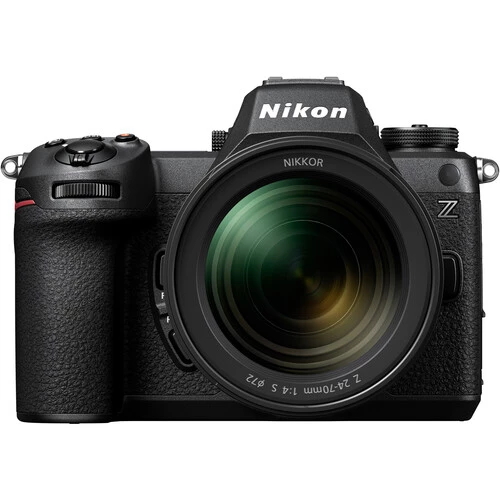
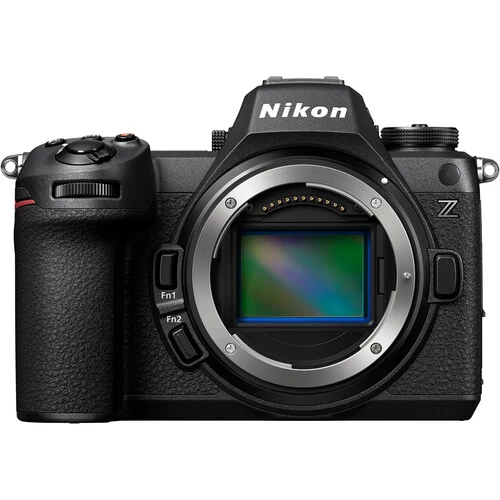
.webp)
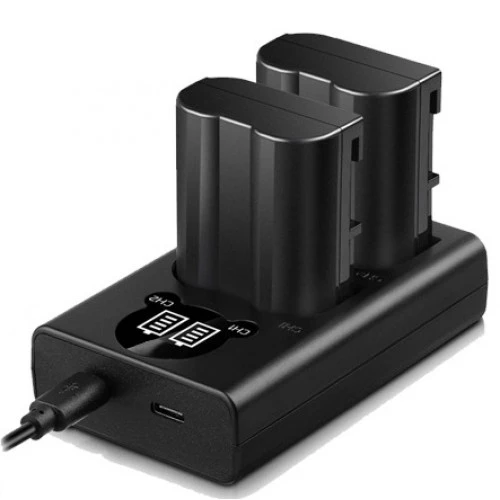
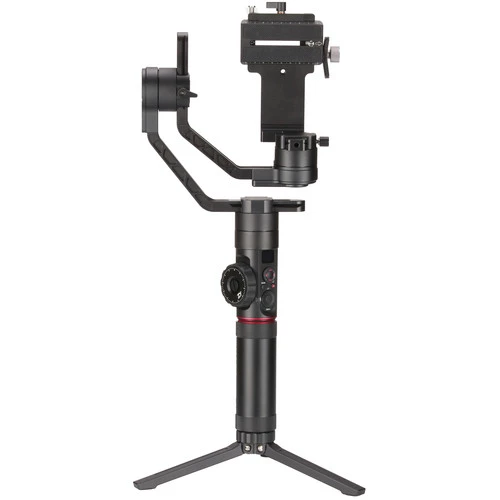
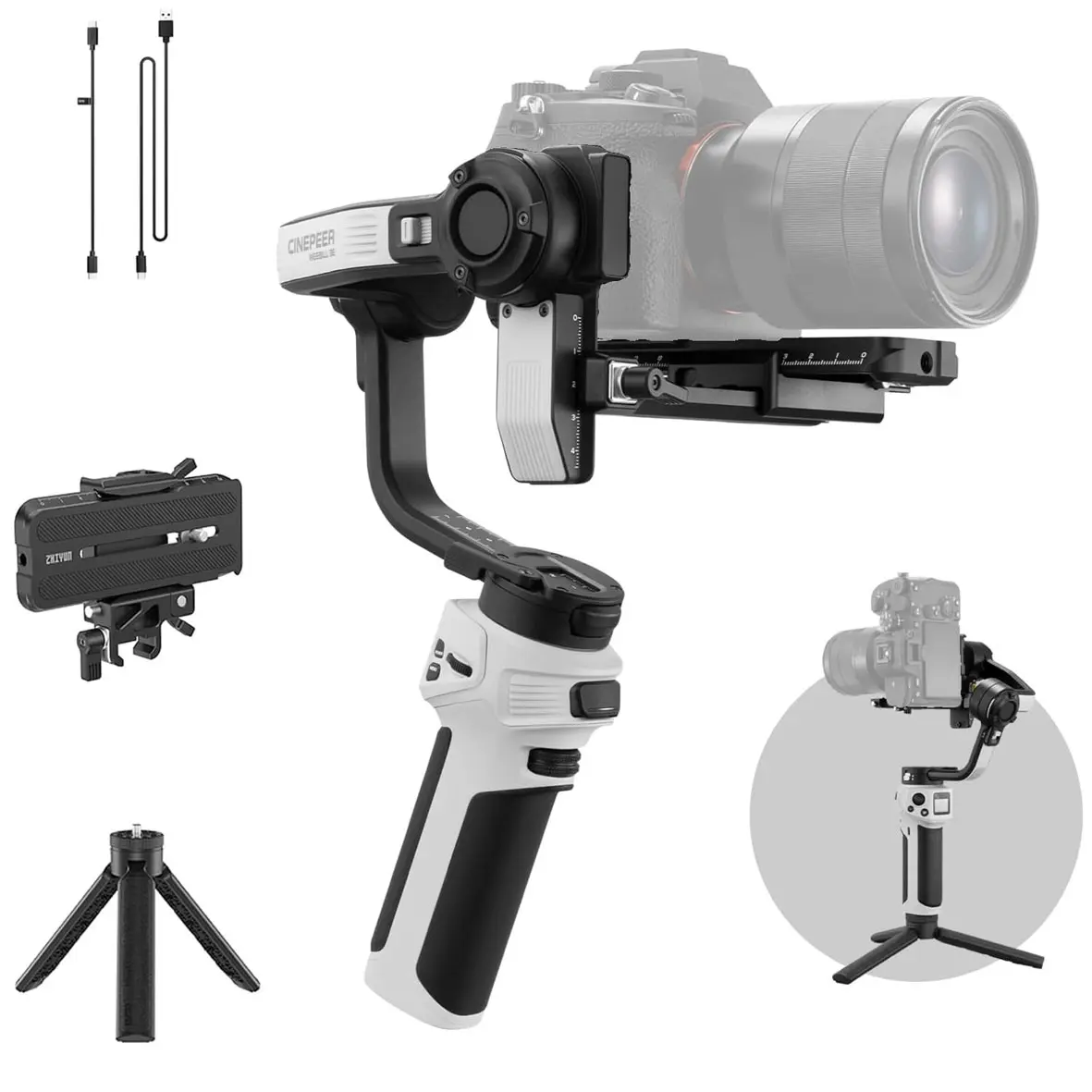
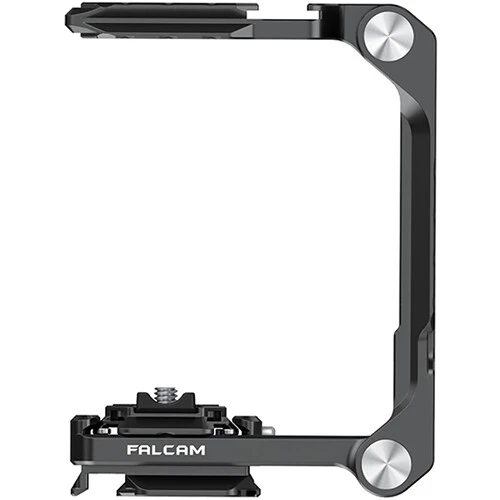
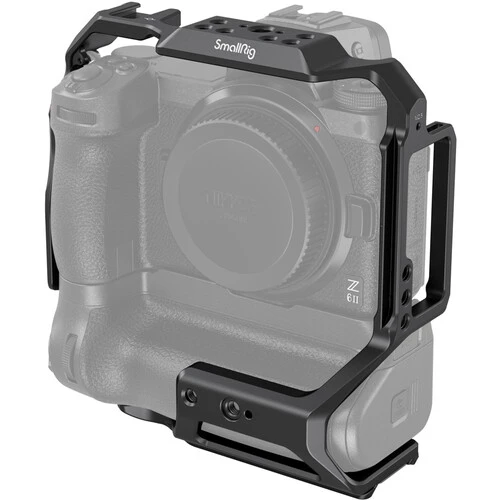
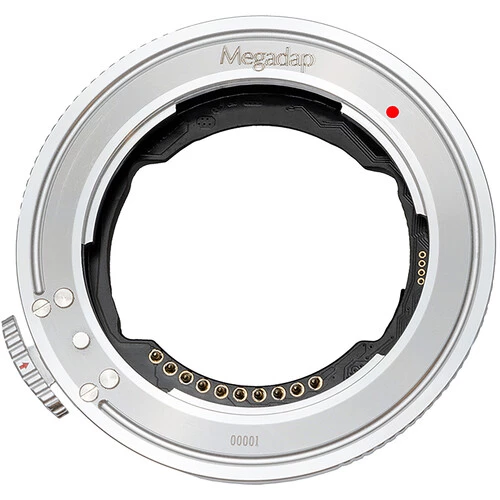
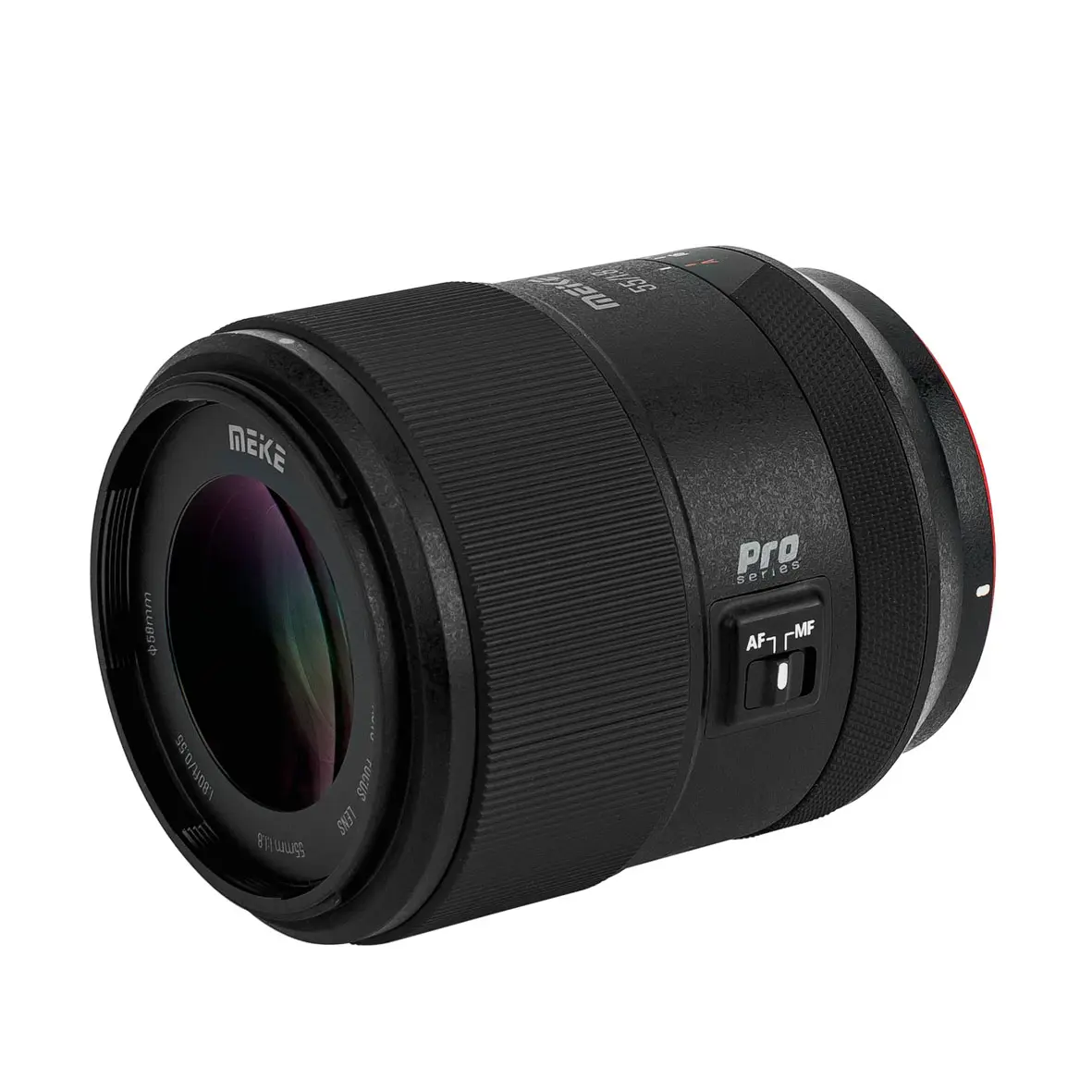
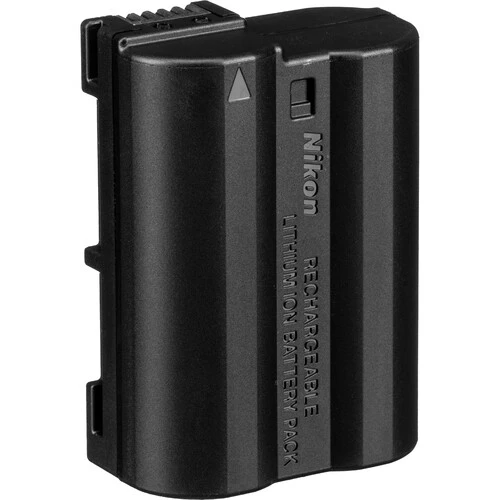
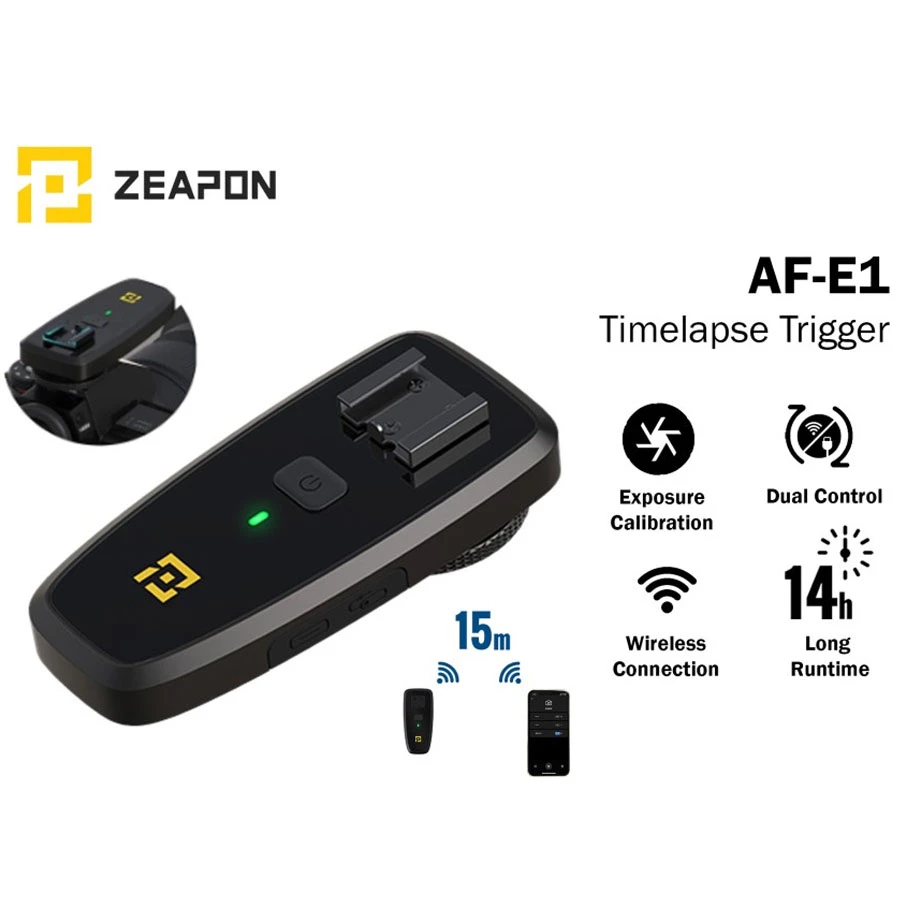
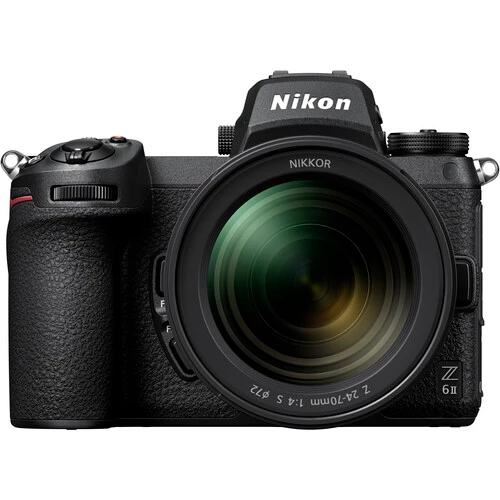
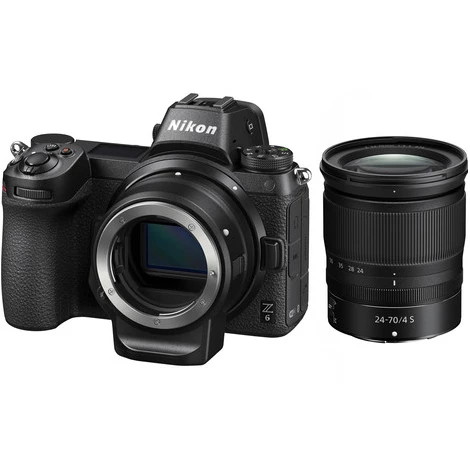
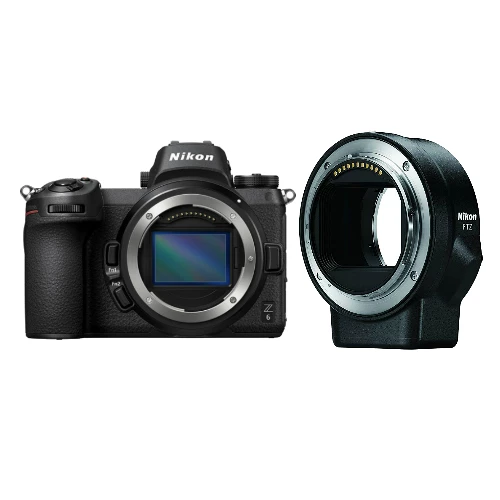
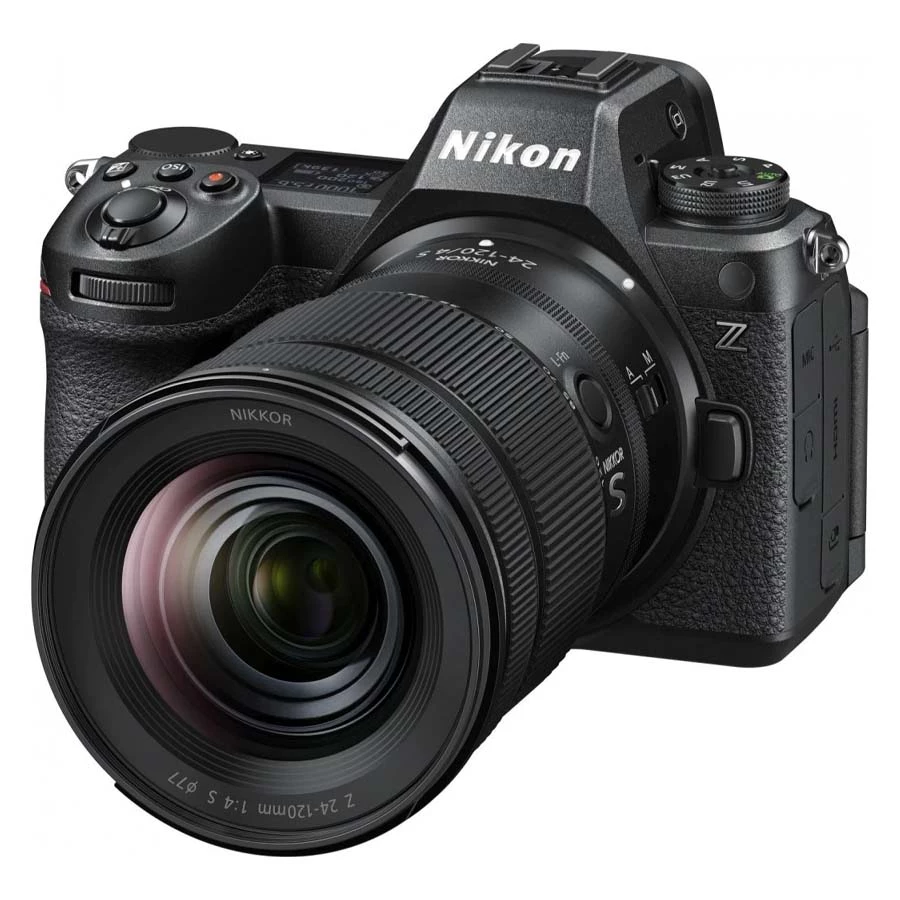
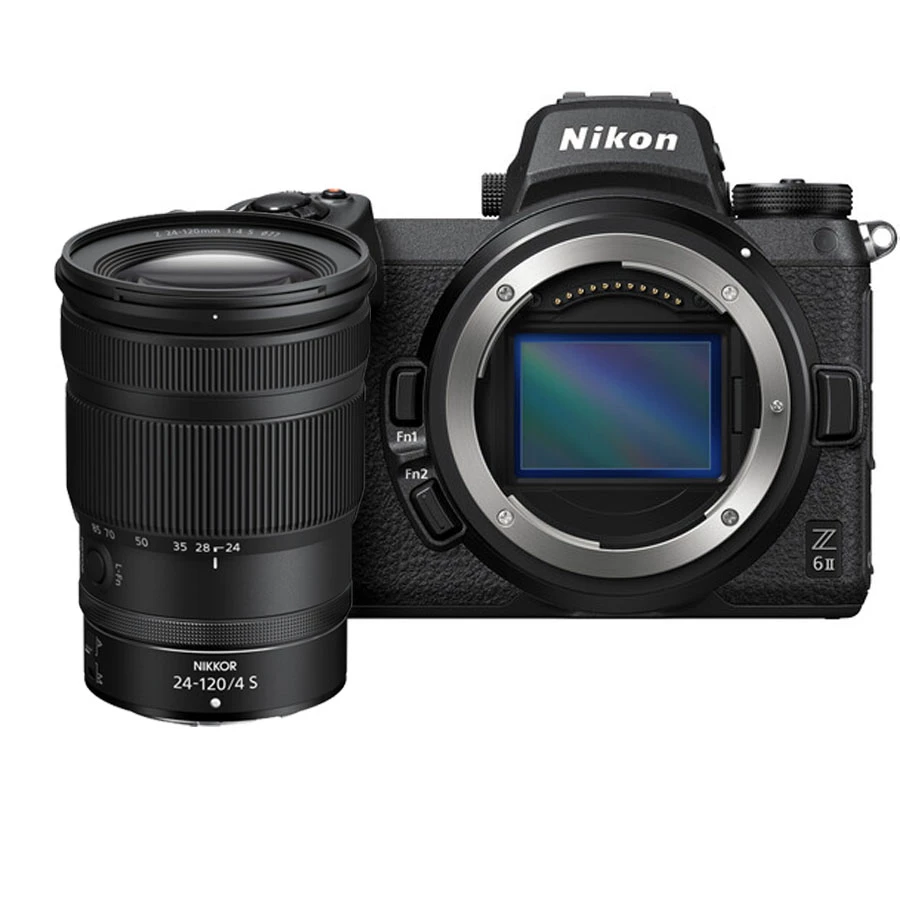
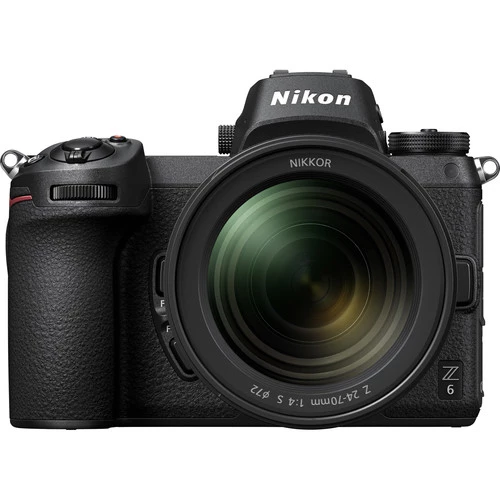
-2-500x500 (1).webp)
